Gambia is home to an incredible variety of birds, with over 500 species residing in the country. From small, colourful finches to majestic vultures, Gambia’s avian population is incredibly diverse and provides amazing opportunities for birdwatching.
The Gambia is particularly known for its migratory species, as many birds flock to the country during winter months. This makes it a paradise for birders, as they get to observe both resident and migratory species. With its diverse habitats, Gambia is home to a wide variety of birds that are sure to delight any birdwatcher.
1. Hamerkop
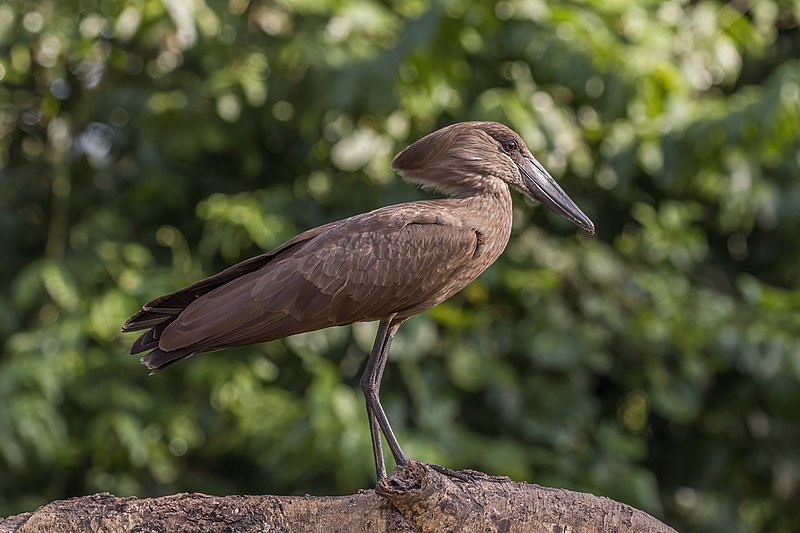
The Hamerkop is a unique wading bird found across sub-Saharan Africa and as far east as India.
It has an unmistakable silhouette, with its long bill topped by a crest at the back of its head that gives it the look of a hammerhead shark.
Its plumage consists mainly of browns and greys, providing excellent camouflage in reed beds.
The species was once classified alongside storks but is now believed to be closely related to pelicans and shoebills instead.
This medium-sized bird feeds on insects, fish, frogs or small reptiles which it captures from shallow water or plucks from trees near bodies of water.
Despite being considered ‘unlucky’ by some cultures due to superstition surrounding their appearance they are actually quite important for controlling populations of certain pests.Scientific classification:
| Kingdom | Animalia |
| Phylum | Chordata |
| Class | Aves |
| Order | Pelecaniformes |
| Family | Scopidae |
| Genus | Scopus |
| Species | S. umbretta |
2. Abyssinian Roller
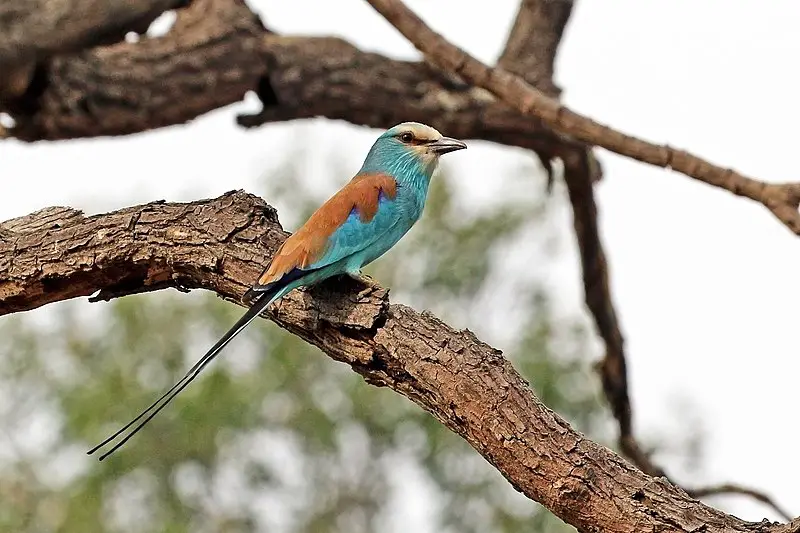
The Abyssinian roller is a large bird, nearly 28 cm in length. It has an unmistakable plumage of bright blue upperparts with chestnut underparts and wings.
Its head is blackish-blue and its tail feathers are white tipped giving it a striking appearance when seen in flight.
This species breeds across tropical Africa from the Sahel belt south of the Sahara desert to East Africa.
Northern populations tend to migrate short distances after wet season while southern ones stay resident throughout year.
They feed mainly on insects which they catch by hovering over fields or open woodland before diving down onto their prey below them.
In addition, they also eat small reptiles, amphibians and rodents along with fruits such as figs occasionally too.Scientific classification:
| Kingdom | Animalia |
| Phylum | Chordata |
| Class | Aves |
| Order | Coraciiformes |
| Family | Coraciidae |
| Genus | Coracias |
| Species | C. abyssinicus |
3. African Jacana
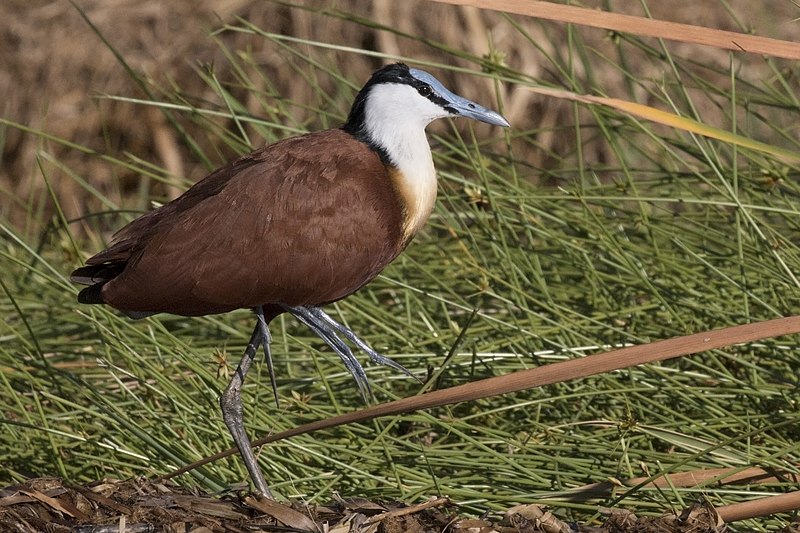
The African Jacana is a charming wader belonging to the family of Jacanidae, mostly found in sub-Saharan Africa.
It has long toes and claws that allow it to walk on floating vegetation in shallow lakes which form its preferred habitat.
The bird was officially described by Johann Friedri in 1789 with an interesting origin and pronunciation for its name -Jacanidae.
This aquatic bird is known for its striking plumage features like yellow crowns and black wings marked with chestnut brown stripes across them, making them look even more attractive when they spread their wing feathers during courtship displays.
They feed mainly on insects, tadpoles, frogs etc., skimming nearby water surface or plucking prey from vegetation as they wander around these wetlands areas.Scientific classification:
| Kingdom | Animalia |
| Phylum | Chordata |
| Class | Aves |
| Order | Charadriiformes |
| Family | Jacanidae |
| Genus | Actophilornis |
| Species | A. africanus |
4. Pied Kingfisher
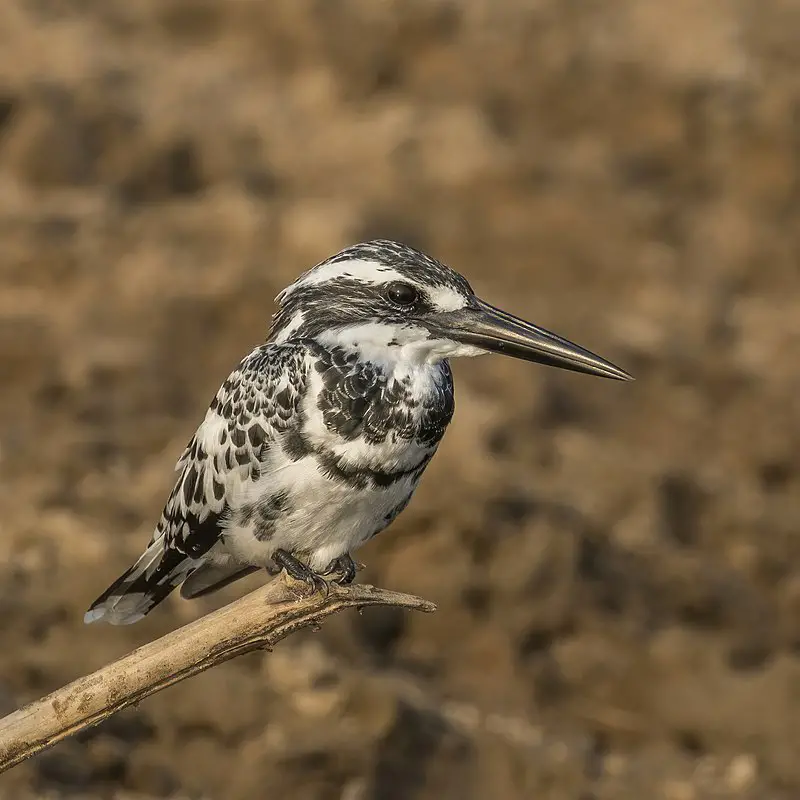
The Pied Kingfisher is a species of water kingfisher found in Africa and Asia. It has black and white plumage, with males sporting a double band across the breast while females have one single band.
This bird makes its presence known by hovering over clear waters before diving for fish – making it easily recognizable.
The diet consists mostly of small aquatic animals such as frogs, crustaceans and insects, but they also consume some plant matter like seeds or fruits occasionally.
The pied kingfisher nests near bodies of water where it can feed off smaller creatures that dwell there; usually in burrows dug into riverbanks or on floating vegetation close to shorelines.
With their distinct colors and behavior patterns these birds make an interesting addition to any wildlife enthusiast’s list.Scientific classification:
| Kingdom | Animalia |
| Phylum | Chordata |
| Class | Aves |
| Order | Coraciiformes |
| Family | Alcedinidae |
| Subfamily | Cerylinae |
| Genus | Ceryle F. Boie, 1828 |
| Species | C. rudis |
5. African Green Pigeon
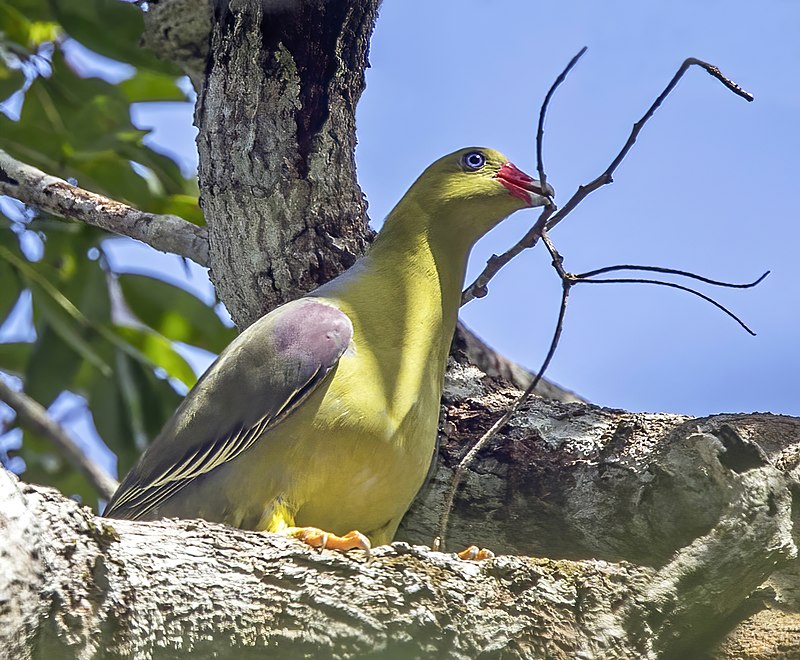
The African green pigeon is an incredibly unique bird that inhabits the Sub-Saharan Africa region.
It has a wide range of accepted races, and its adults have maroon patches on their wings while juveniles are olive in color.
Its upperparts can be grayish-green to yellowish-green with a white throat, barred underparts and clean legs. This species feeds mainly on fruit but may also consume seeds or insects.
It typically nests in trees near water or swamps where it builds platforms made from twigs for laying eggs which hatch after 2 weeks of incubation period by both parents sharing the duties equally .
The African green pigeon is quite vocal during mating season as well as when alarmed; often using whistles “kiu” notes to communicate with each other in flocks up to 30 birds at a time.Scientific classification:
| Kingdom | Animalia |
| Phylum | Chordata |
| Class | Aves |
| Order | Columbiformes |
| Family | Columbidae |
| Genus | Treron |
| Species | T. calvus |
6. Blue-Breasted Kingfisher
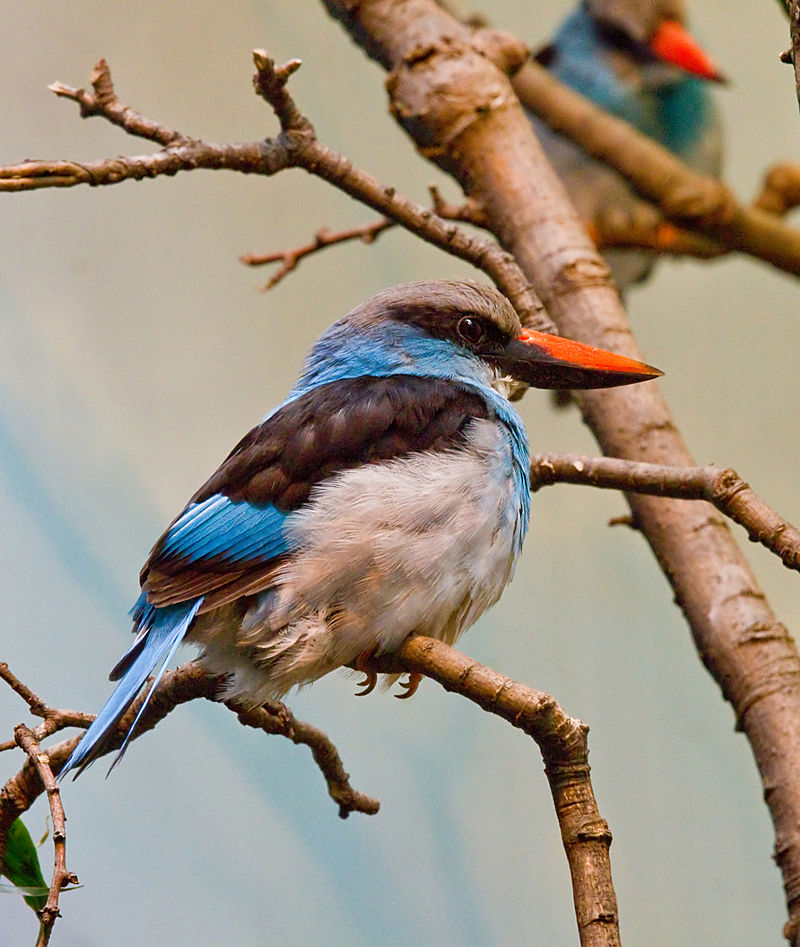
The Blue-breasted Kingfisher is a striking species of bird native to Equatorial Africa. Measuring 25 cm in length, this tree kingfisher has bright blue feathers on its head, back, wings and tail.
Its underparts are white with a contrasting blue breast band for added visual interest.
Though essentially resident there, it does migrate from drier savannas to wetter habitats during the dry season in order to survive better.
This species feeds mainly on insects such as beetles and grasshoppers but will also take small fish when available near the shorelines or riverside vegetation they inhabit.
The beautiful song of these birds can often be heard echoing through their natural environment – an unmistakable sound that makes them easily recognizable.Scientific classification:
| Kingdom | Animalia |
| Phylum | Chordata |
| Class | Aves |
| Order | Coraciiformes |
| Family | Alcedinidae |
| Subfamily | Halcyoninae |
| Genus | Halcyon |
| Species | H. malimbica |
7. Woodland Kingfisher
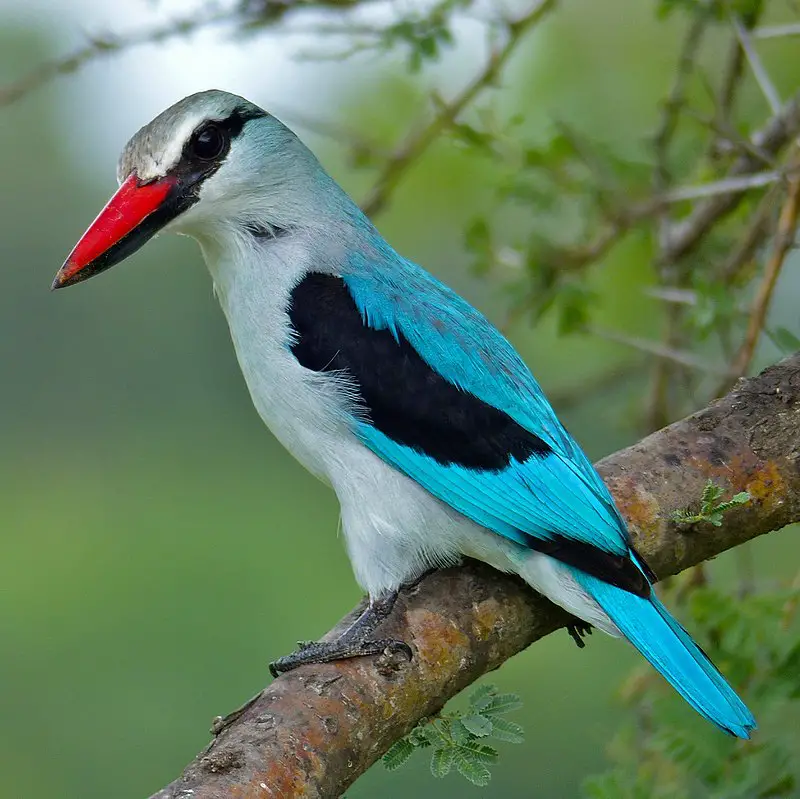
The Woodland Kingfisher is a beautiful bird, native to Africa south of the Sahara. It was first described in 1766 by Carl Linnaeus who called it Alcedo senegalensis.
This tree kingfisher has an attractive blue and white plumage with some red and black markings on its wings, tail and head.
The male also has a bright orange beak which helps to distinguish him from the female whose beak is yellowish-green.
These birds can usually be found in wooded areas near water sources such as rivers or lakes where they hunt for food including fish, frogs, small insects and even lizards.
They build their nests either high up in trees or inside holes dug out of banks near rivers and ponds.
Although not threatened yet, these lovely creatures need our protection so that future generations will have the chance to marvel at them too.Scientific classification:
| Kingdom | Animalia |
| Phylum | Chordata |
| Class | Aves |
| Order | Coraciiformes |
| Family | Alcedinidae |
| Subfamily | Halcyoninae |
| Genus | Halcyon |
| Species | H. senegalensis |
8. Bruce’s Green Pigeon
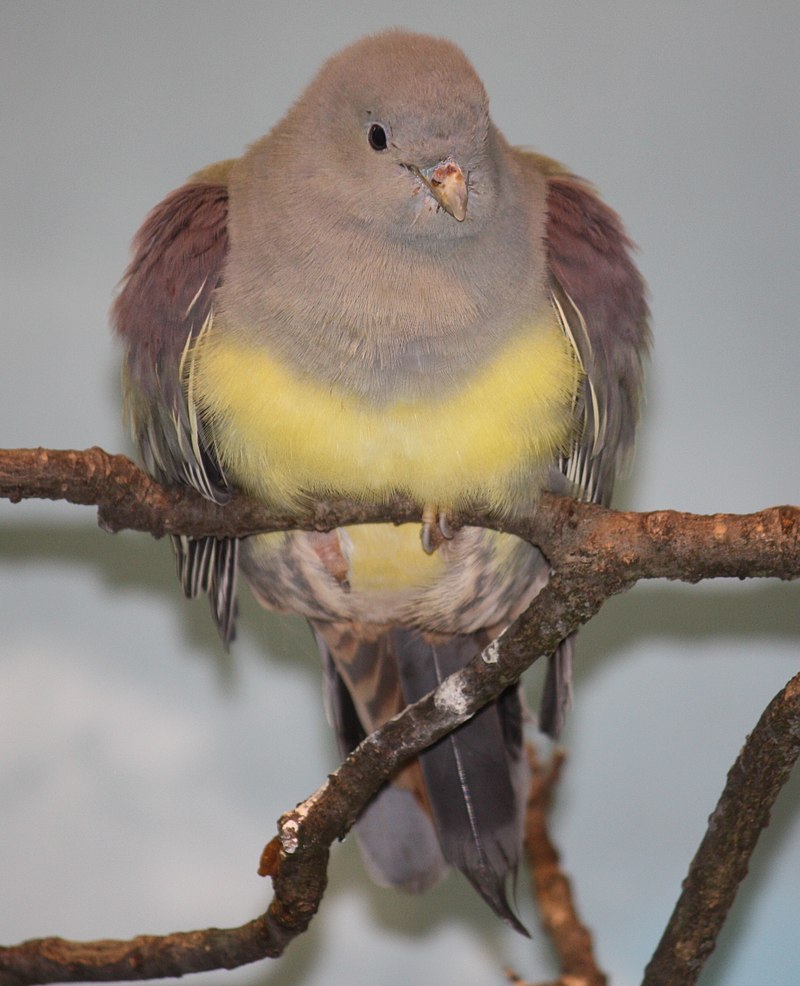
Bruce’s green pigeon is a species of bird in the Columbidae family, and can be found across Africa and some parts of the Middle East.
It has light grey plumage on its head, neck and chest area with darker wings that have white tips.
The most distinguishing feature of this bird is its bright yellow belly which stands out against its otherwise dull colouring.
Its diet mainly consists of fruits such as figs, dates or olives but it will also feed on buds or flowers when necessary.
Bruce’s green pigeons are usually seen alone or in pairs but may congregate in groups to forage together when food sources are plentiful.
They make their nests high up in trees where they lay two eggs at a time which both parents take turns incubating until hatching takes place after an 18 day period.Scientific classification:
| Kingdom | Animalia |
| Phylum | Chordata |
| Class | Aves |
| Order | Columbiformes |
| Family | Columbidae |
| Genus | Treron |
| Species | T. waalia |
9. Striped Kingfisher
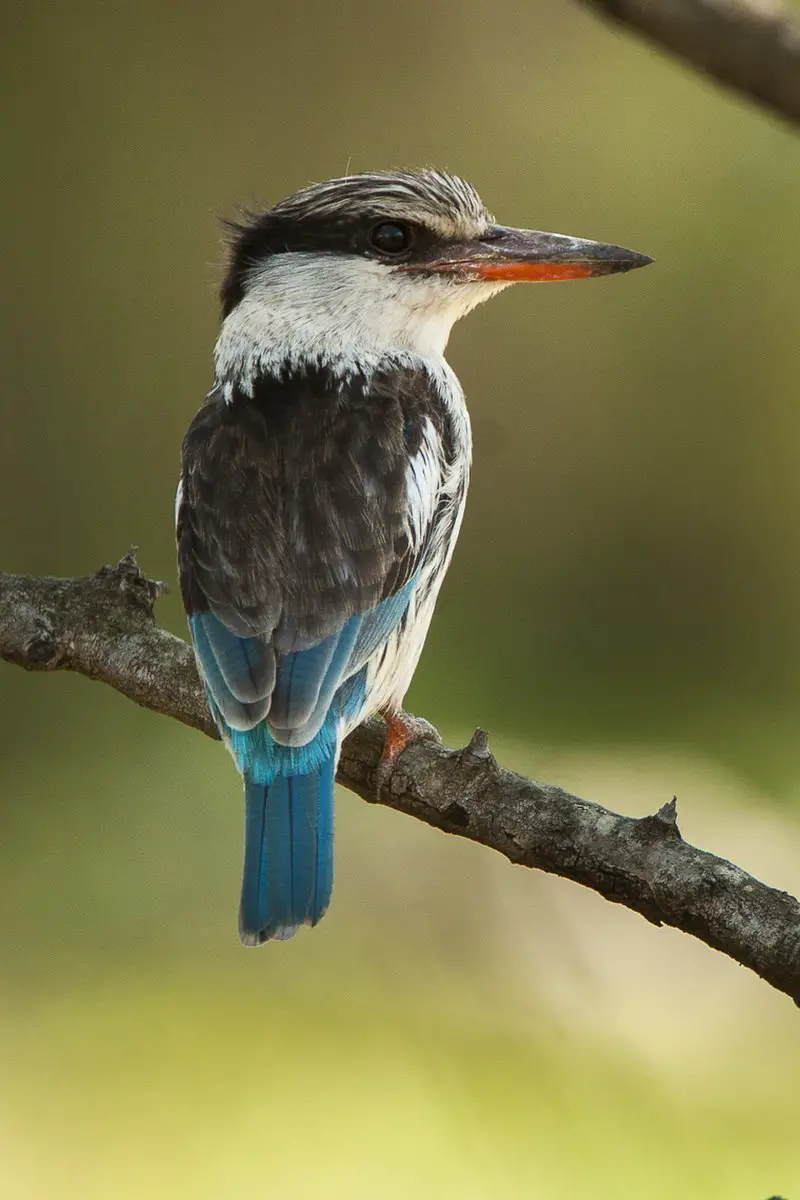
The Striped Kingfisher is a species of bird in the tree kingfisher subfamily.
It was first described by Edward, Lord Stanley as Alaudo Chelicuti and its genus name Halcyon comes from an ancient Greek legend which associates it with the kingfisher.
This beautiful bird has distinctive black stripes on its back and wings, along with bright blue feathers covering most of its body.
The bill is large and stout while the legs are short but strong for perching on branches or diving into water to catch prey such as fish or crustaceans.
Its call consists of loud chirps that can be heard over long distances making it easy to identify in forests near streams or rivers during migration season when they travel through Africa towards Asia between October-March each year.Scientific classification:
| Kingdom | Animalia |
| Phylum | Chordata |
| Class | Aves |
| Order | Coraciiformes |
| Family | Alcedinidae |
| Subfamily | Halcyoninae |
| Genus | Halcyon |
| Species | H. chelicuti |
10. Red-Throated Bee-Eater
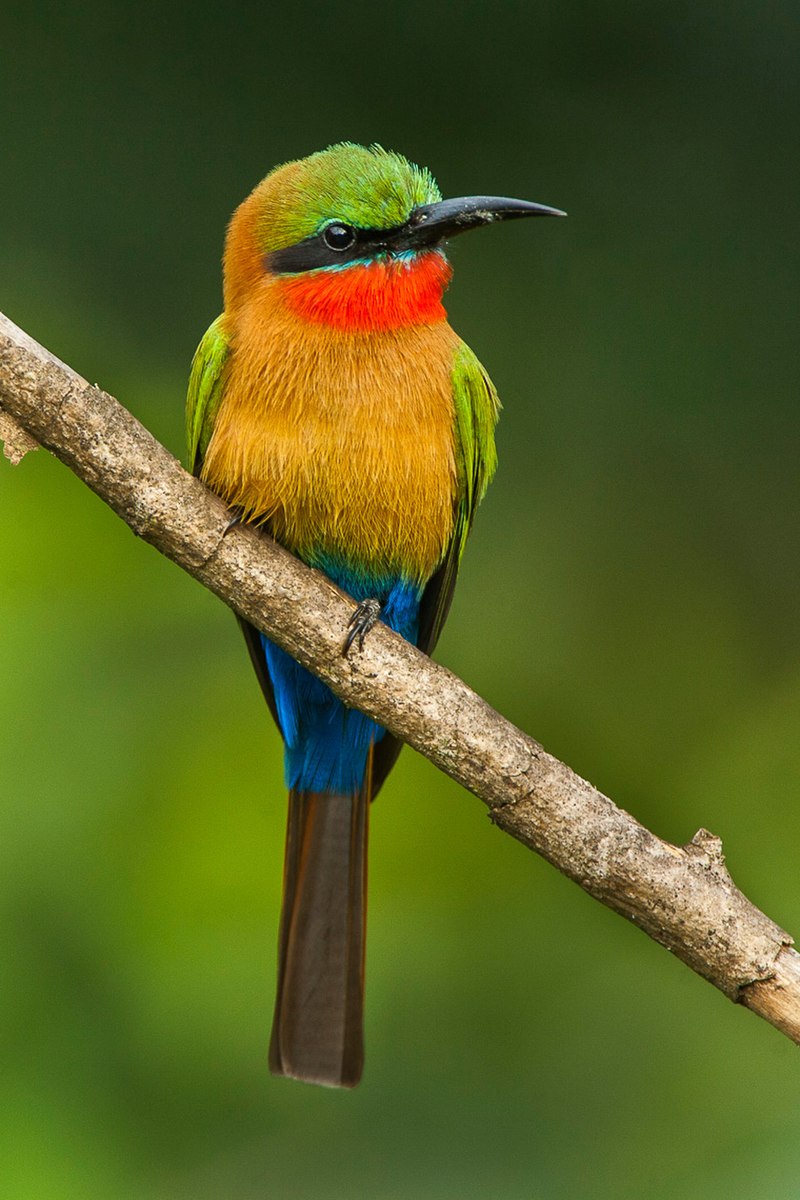
The Red-throated Bee-eater is a beautiful species of bird found in tropical Africa. It has bright red feathers covering its throat, giving it a distinct look.
Its body is mostly brown with white stripes and its wings are dark blue on the tips.
This species enjoys an extensive range throughout countries like Benin, Burkina Faso, and Togo to name just a few.
These birds feed mainly on insects that they catch in midair or from nearby foliage during their hunting flights over open country habitats such as woodlands and savannas.
While not much else is known about this particular type of bee-eater, these colorful creatures have surely become quite popular due to their striking beauty.Scientific classification:
| Kingdom | Animalia |
| Phylum | Chordata |
| Class | Aves |
| Order | Coraciiformes |
| Family | Meropidae |
| Genus | Merops |
| Species | M. bulocki |
11. Northern Carmine Bee-Eater
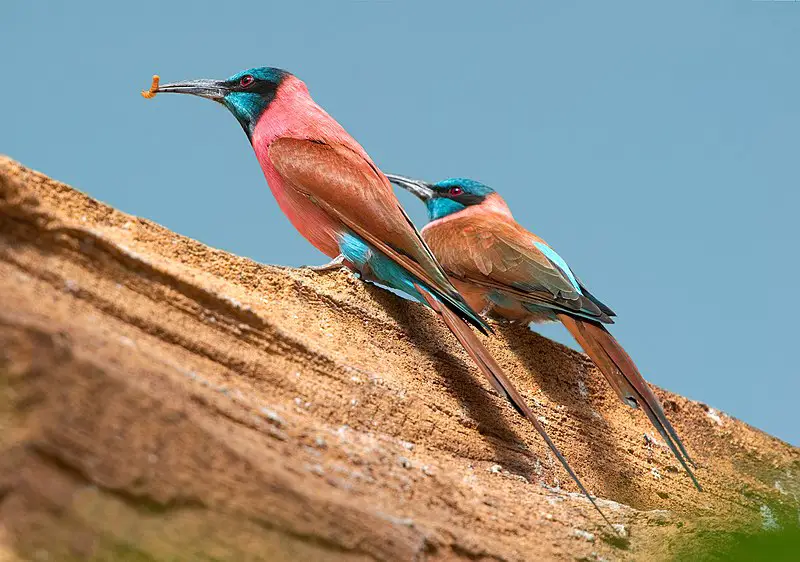
The Northern Carmine Bee-eater is a beautiful bird with striking colors. It has bright red and blue plumage, with the throat being predominantly carmine in color.
This species of bee-eater can be found throughout northern tropical Africa, from Senegal east to Somalia, Ethiopia and Kenya.
It was previously assumed to be closely related to the Southern Carmine Bee-eater which has a scarlet colored throat instead of blue as seen in this species.
The Northern Carmine Bee-Eater feeds on flying insects such as bees and other small creatures that it catches midair using its sharp claws and bill for grabbing them quickly before they escape.Scientific classification:
| Kingdom | Animalia |
| Phylum | Chordata |
| Class | Aves |
| Order | Coraciiformes |
| Family | Meropidae |
| Genus | Merops |
| Species | M. nubicus |
12. White-Throated Bee-Eater
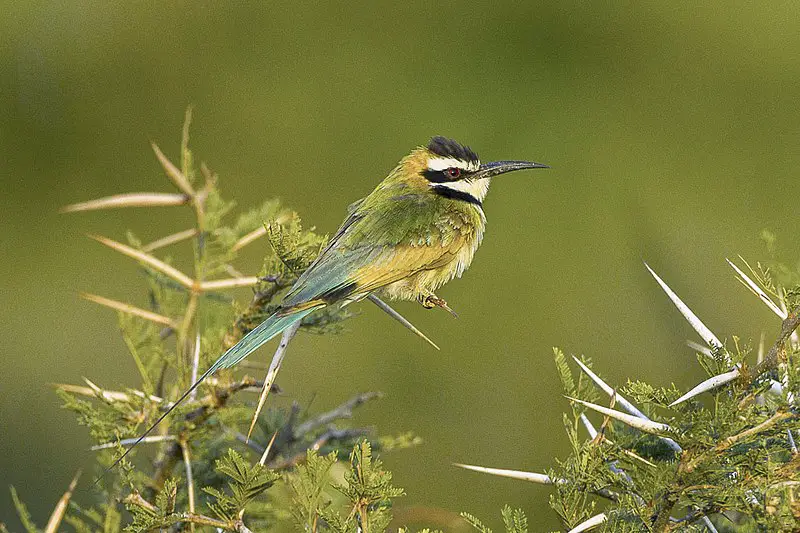
The White-throated bee-eater is a stunningly colourful bird that belongs to the Meropidae family in the near passerine category.
It breeds in semi-desert regions along southern Sahara and migrates during winter months to equatorial rain forests from Senegal to Uganda, where it enjoys different habitat experiences.
Its plumage consists of bright blues, greens and yellows with a distinctive white throat patch which gives it its name.
They feed on insects such as bees, dragonflies and wasps by catching them mid flight or plucking them off vegetation before returning back to their perch spot for eating; they perform aerial acrobatics while hunting.
These birds are social creatures who form colonies when breeding season arrives around springtime.
Their nests consist of tunnels dug up into sandy banks or termite mounds lined with grasses providing protection against predators like snakes and monitor lizards making this species an excellent example of adaptation in nature.Scientific classification:
| Kingdom | Animalia |
| Phylum | Chordata |
| Class | Aves |
| Order | Coraciiformes |
| Family | Meropidae |
| Genus | Merops |
| Species | M. albicollis |
13. Blue-Bellied Roller
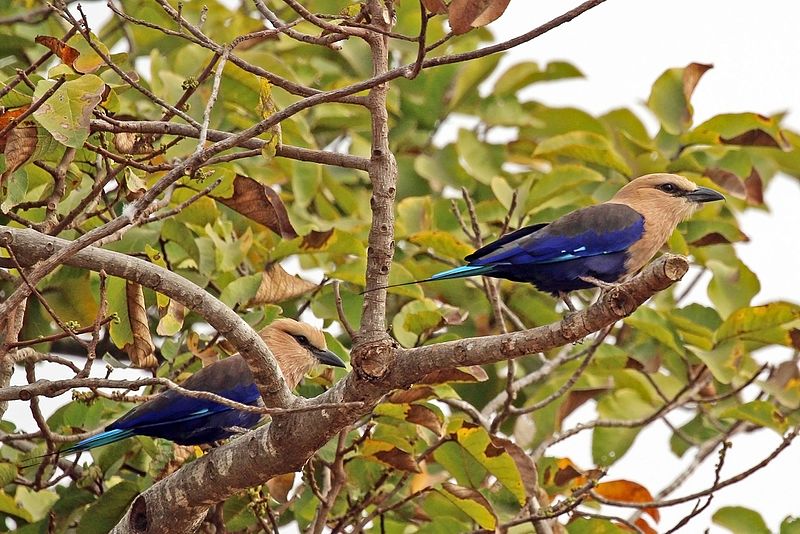
The Blue-bellied Roller is a stunning bird native to Africa. It has beautiful blue wings and underside, contrasting with its otherwise brown feathers.
This species of roller typically resides in moist savannahs dominated by Isoberlinia trees where there is an abundance of mature vegetation for them to feed on.
Its range stretches from Senegal all the way up to northeast Democratic Republic Congo, although it may migrate seasonally within this area.
The first description and binomial name Coracias cyanogaster was given by Fre in 1816; since then they have remained largely unchanged as they are well adapted to their environment.Scientific classification:
| Kingdom | Animalia |
| Phylum | Chordata |
| Class | Aves |
| Order | Coraciiformes |
| Family | Coraciidae |
| Genus | Coracias |
| Species | C. cyanogaster |
14. Greater Painted-Snipe
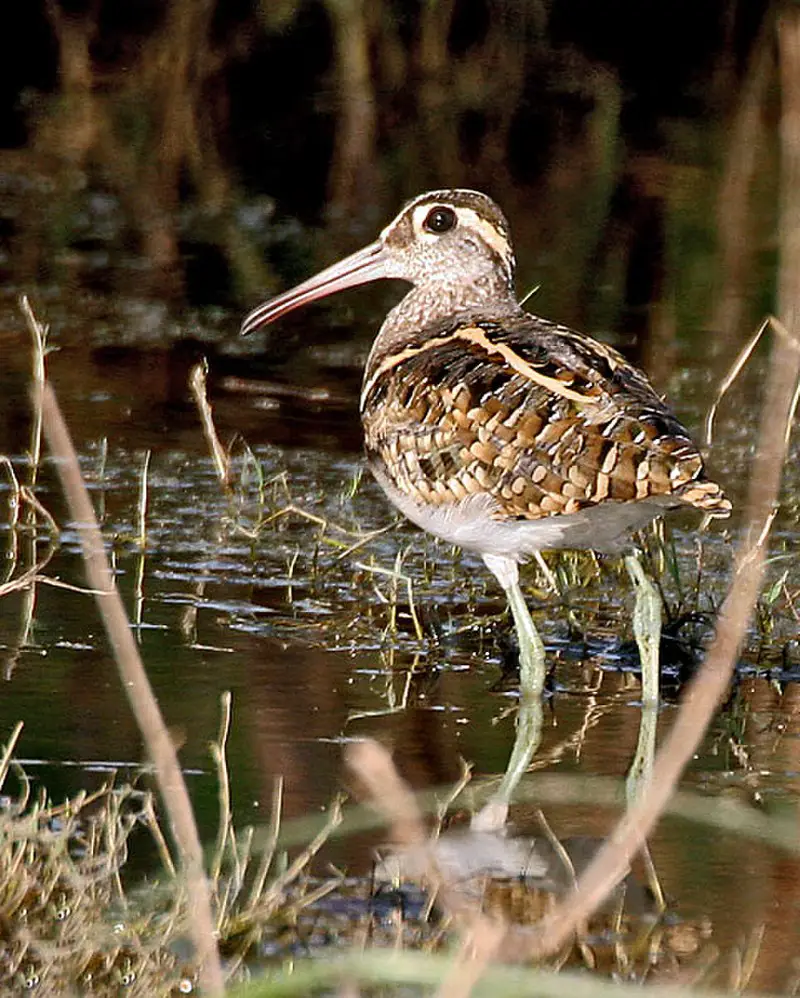
The Greater Painted-snipe is a medium-sized, plump wading bird found in marshes throughout Africa, South Asia and Southeast Asia.
It has distinctive features that make it stand out from its peers: a long reddish brown bill slightly curved at the tip with an eye patch of white or pinkish coloration; rounded wings speckled with buff spots; and a short tail.
The breast of this species has extensive white plumage which extends up around the top of its folded wing.
With its unique appearance, this avian beauty stands out among other birds in wetland habitats.Scientific classification:
| Kingdom | Animalia |
| Phylum | Chordata |
| Class | Aves |
| Order | Charadriiformes |
| Family | Rostratulidae |
| Genus | Rostratula |
| Species | R. benghalensis |
15. Pink-Backed Pelican
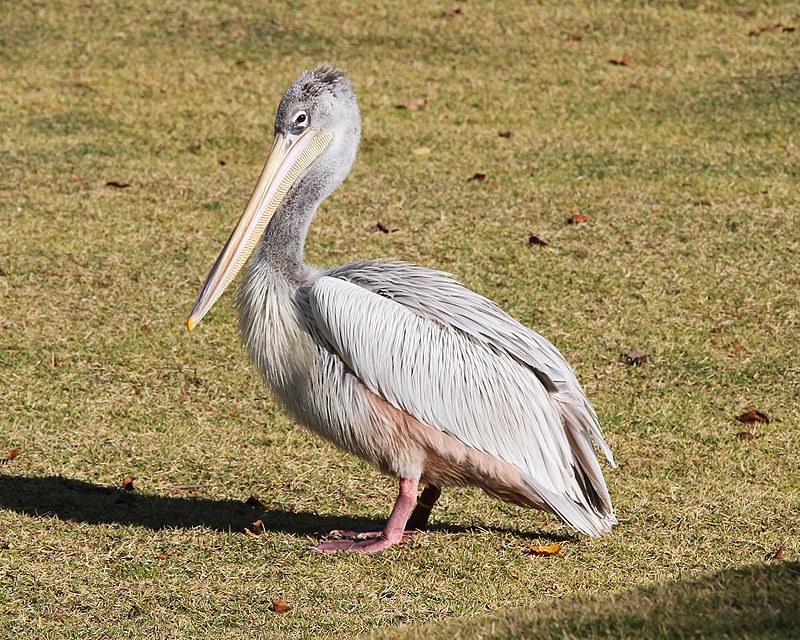
The Pink-backed Pelican is a beautiful bird of the pelican family, found in Africa and southern Arabia.
They are resident breeders that inhabit swamps and shallow lakes, but were once seen in Madagascar as well.
It was formally described by German naturalist Johann Friedrich Gmelin back in 1789.
These birds have unique pink feathers on their backs which gives them their name along with grey or white heads with black wing tips.
They use their long beaks to scoop up fish from the water then drain out excess water before swallowing it whole.
The diet of these birds consists mainly of small fish like anchovies, sardines, and other types offish they can find near the surface of rivers or lakes.
With its long wingspan ranging between 2 – 3 feet (60 – 90 cm), this species has adapted perfectly for gliding over bodies of water while searching for prey to eat.Scientific classification:
| Kingdom | Animalia |
| Phylum | Chordata |
| Class | Aves |
| Order | Pelecaniformes |
| Family | Pelecanidae |
| Genus | Pelecanus |
| Species | P. rufescens |
16. Blue-Cheeked Bee-Eater
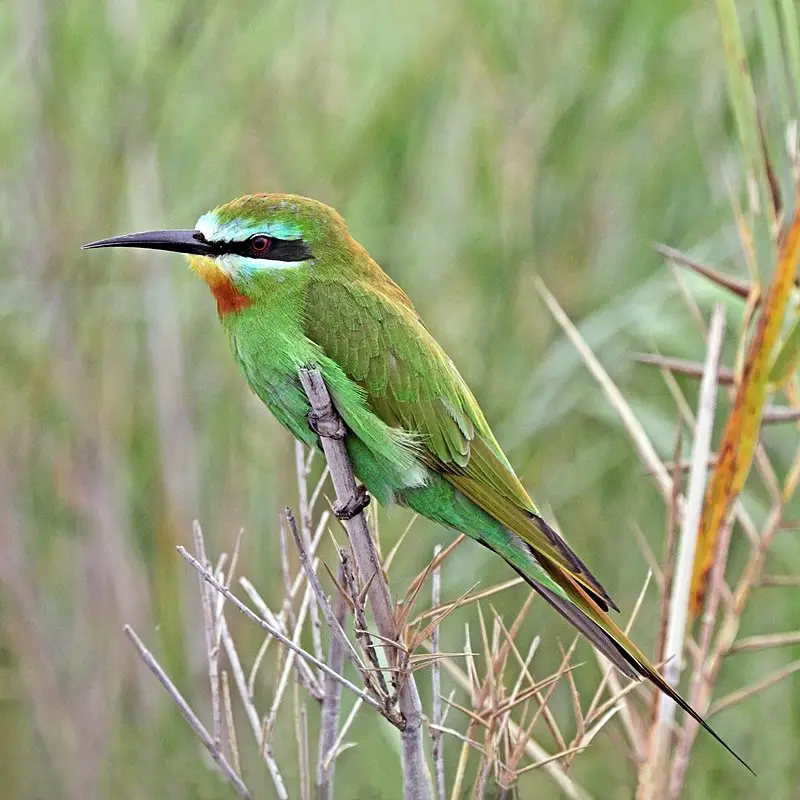
The Blue-cheeked Bee-eater (Merops persicus) is a stunningly beautiful bird belonging to the Meropidae family. It has an unmistakeable blue coloring on its cheeks and neck, which stands out against its yellow body plumage.
This species of bee-eater can be found in Northern Africa, Middle East countries from Turkey eastwards till Kazakhstan, and India as well.
During winter they migrate south to tropical regions of Africa while some populations remain put for breeding purposes year round.
They are adept at catching insects midair with their long curved bills which makes them excellent predators in open grasslands or savannas where bees and other insects thrive abundantly.
So if you ever happen across these vibrant beauties make sure to take a moment pause and appreciate nature’s wonders.Scientific classification:
| Kingdom | Animalia |
| Phylum | Chordata |
| Class | Aves |
| Order | Coraciiformes |
| Family | Meropidae |
| Genus | Merops |
| Species | M. persicus |
17. Swallow-Tailed Bee-Eater
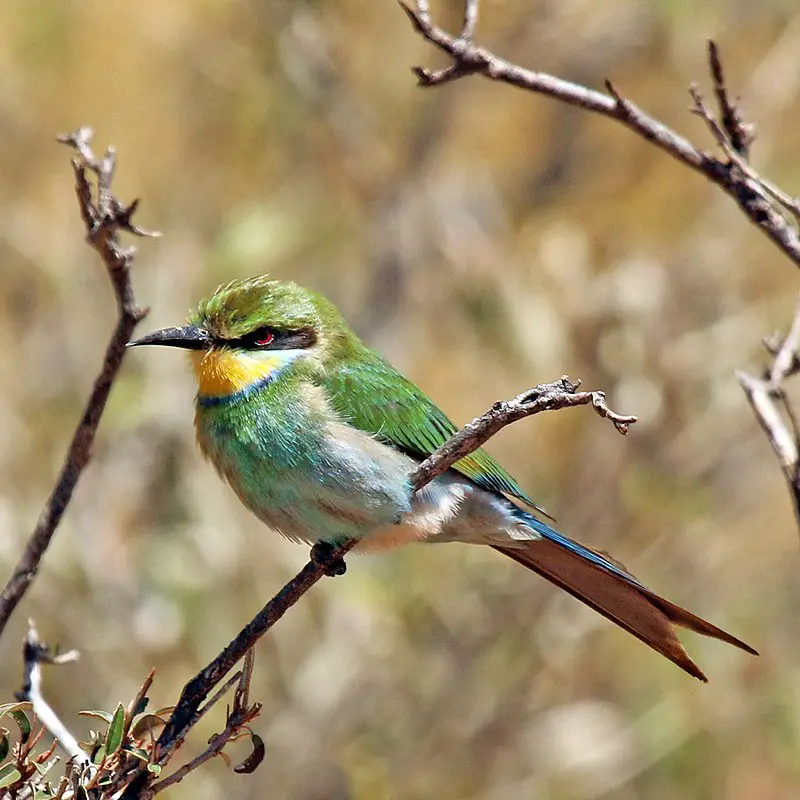
The Swallow-tailed bee-eater is a stunning bird, easily recognizable by its vibrant colours and forked tail. It has a green body with yellow throat, blue gorget and black eye stripe and beak.
Growing up to 20 – 22 cm in length from head to tail, these birds are quite slender.
They feed on insects such as bees, wasps or dragonflies that they catch in mid air before returning back to their perch where the prey is eaten.
These birds live in flocks of about 10 – 50 individuals which helps them protect against predators by forming an alert system amongst themselves when danger nears around them.
Being diurnal creatures, during night time they roost together over water streams or small trees making loud calls so as not to get lost while searching for each other come morning light.Scientific classification:
| Kingdom | Animalia |
| Phylum | Chordata |
| Class | Aves |
| Order | Coraciiformes |
| Family | Meropidae |
| Genus | Merops |
| Species | M. hirundineus |
18. Allen’s Gallinule
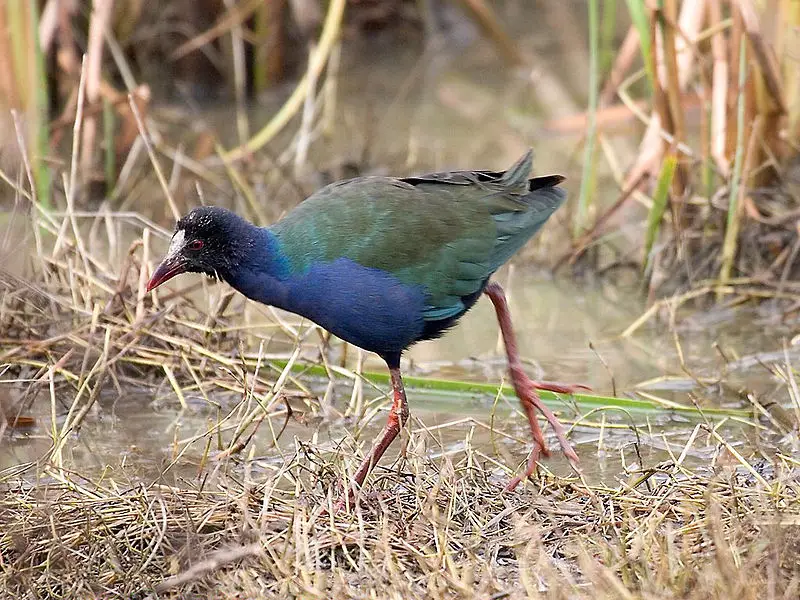
Allen’s gallinule is a small waterbird belonging to the family Rallidae. Its scientific name, Porphyrio alleni, commemorates British naval officer Rear-Admiral William Allen (1792–1864).
It breeds in marshes and lakes across Sub-Saharan Africa. The bird usually builds its nest on floating vegetation or platforms of reeds near water bodies.
It feeds mainly on aquatic plants, tadpoles and insects that it finds while swimming in shallow waters or walking along the edges of wetlands.
They are highly social birds often seen foraging together with other species such as moorhens and coots.
The male is identified by his bright blue bill whereas females have brown bills with yellow tips during breeding season which helps them attract potential mates.
Allen’s Gallinules are quite vocal creatures making loud alarm calls when threatened by predators like eagles or herons which makes them interesting avian inhabitants of African wetlands.Scientific classification:
| Kingdom | Animalia |
| Phylum | Chordata |
| Class | Aves |
| Order | Gruiformes |
| Family | Rallidae |
| Genus | Porphyrio |
| Species | P. alleni |
19. Senegal Coucal
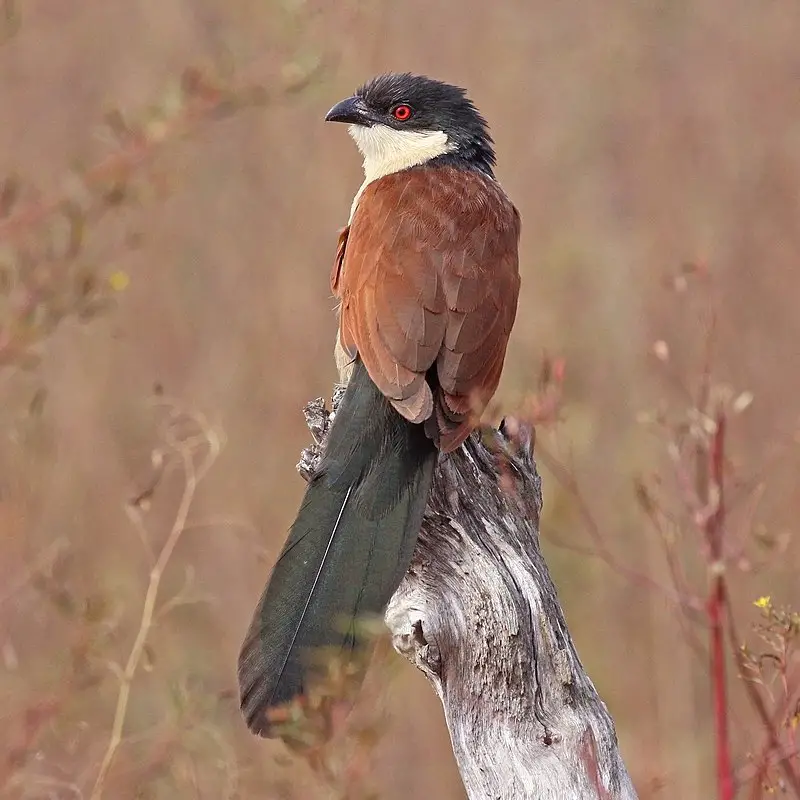
The Senegal coucal is a cuckoo-like bird native to Central and Southern Africa. It has a medium-sized body with black wings, tail and head along with white breast feathers.
Its natural habitat consists of lightly wooded savannahs where it feeds on insects, small reptiles, amphibians and fruits.
This species can be found in pairs or alone atop low bushes searching for prey or perched up high singing its distinctive song that features a mix of harsh notes as well as melodic ones.
The Senegal coucal enjoys the sun’s rays but also loves sheltering in dense vegetation when danger arises nearby.
Overall this beautiful bird makes an interesting addition to any backyard garden.Scientific classification:
| Kingdom | Animalia |
| Phylum | Chordata |
| Class | Aves |
| Order | Cuculiformes |
| Family | Cuculidae |
| Genus | Centropus |
| Species | C. senegalensis |
20. Black Coucal
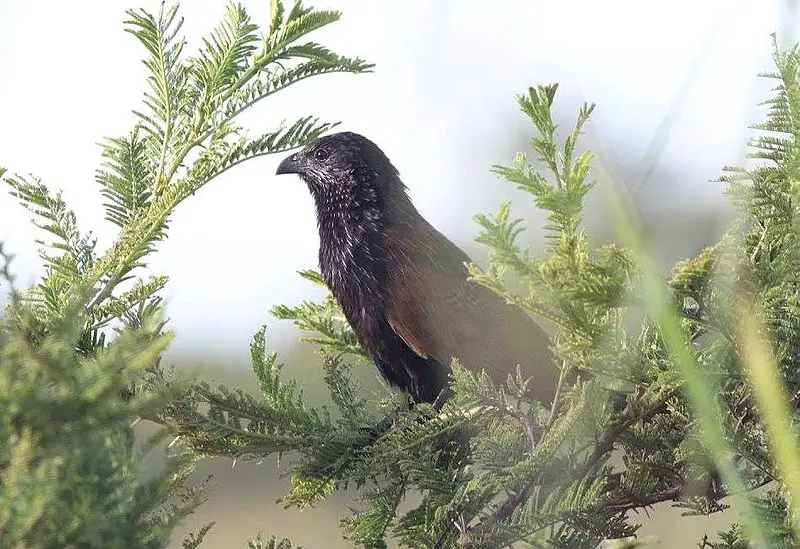
Black coucal is a species of cuckoo found in Africa south of the Sahara. Males are 30 cm long while females are 34 cm, both having similar appearance with black head and body along with buff barring on rump.
Wings have a reddish tinge to them making it easier to spot in its habitat. They breed during rains when food sources become abundant for their young ones.
Their diet consists mostly of insects like grasshoppers, beetles and caterpillars which they hunt from ground or trees depending on where their prey reside.
With such widespread distribution across Africa, this bird serves as an important part of the ecosystem by controlling insect population levels naturally thereby maintaining balance between various organisms living there.Scientific classification:
| Kingdom | Animalia |
| Phylum | Chordata |
| Class | Aves |
| Order | Cuculiformes |
| Family | Cuculidae |
| Genus | Centropus |
| Species | C. grillii |
21. Klaas’s Cuckoo
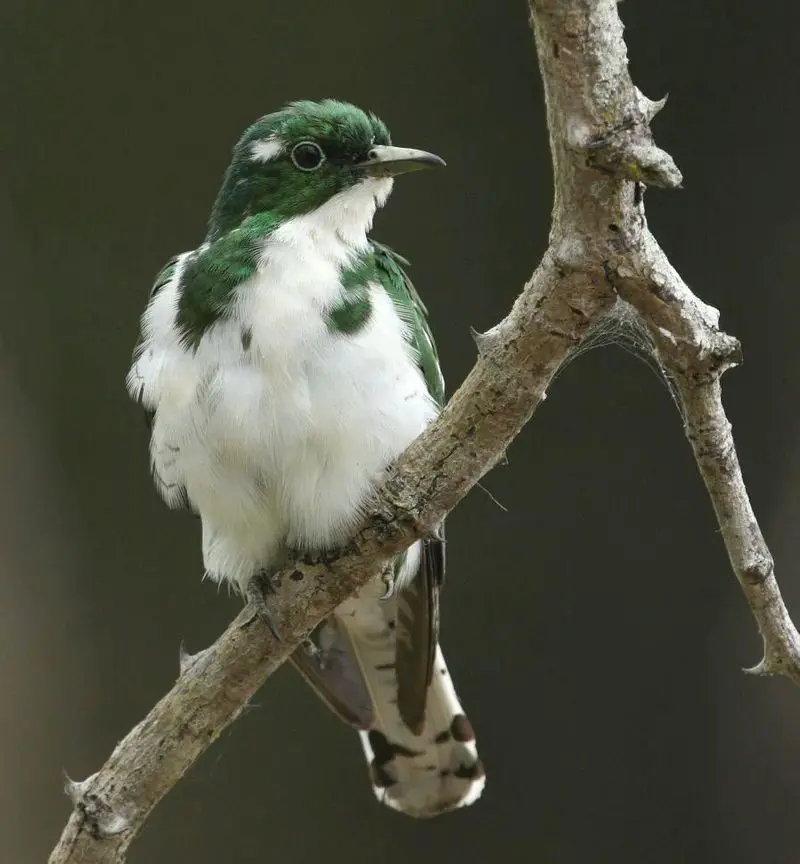
Klaas’s cuckoo is a species of bird found in the wooded areas of sub-Saharan Africa.
The unique species was named after Klaas, the Khoikhoi man who collected the first specimen and presented it to French explorer François Le Vaillant in 1806.
It belongs to the family Cuculidae which encompasses many cuckoos around the world including Old World cuckoos native to Eurasia and New World tropical cuckoos from Central and South America.
This small bird can be identified by its greyish back, white belly with dark streaks on either side, yellowish brown wings with black tips along tail feathers, red eyes, pale bill and blue legs.
Its diet consists mainly of insects such as caterpillars while they are also known for their parasitic behaviour where they lay eggs inside other birds’ nests instead of building their own nest or incubating them themselves.
All in all , Klaas’s cukcoo is an interesting yet enigmatic creature that has been studied for centuries but still holds much mystery about itself.Scientific classification:
| Kingdom | Animalia |
| Phylum | Chordata |
| Class | Aves |
| Order | Cuculiformes |
| Family | Cuculidae |
| Genus | Chrysococcyx |
| Species | C. klaas |
22. White-Spotted Flufftail
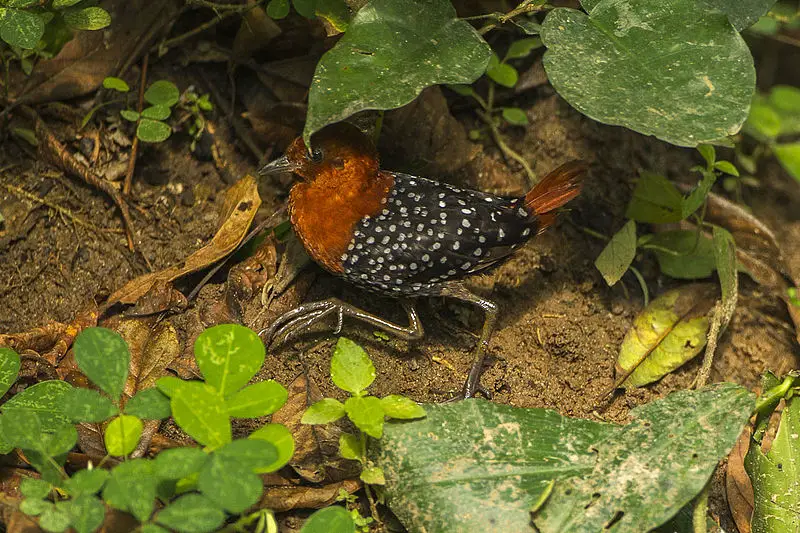
The white-spotted flufftail is a species of bird from the family Sarothruridae. It can be found in tropical rainforest regions across Africa, and its habitat consists of dense vegetation.
The colouration of this small bird is quite striking; it has a grey back, with reddish undertail coverts and black wings that are edged with white spots.
Its head features shades of brown and yellow, while its throat is notably creamy coloured.
These birds feed mainly on insects such as caterpillars but will also consume smaller amounts of fruit when available.
They build nests near water sources or under thick foliage to protect them from predators like hawks or crows which may attack their eggs or young chicks if they get too close by chance.
All in all, the white-spotted flufftail plays an important role in African ecology due to its insectivorous diet habits that help keep pest populations at bay.Scientific classification:
| Kingdom | Animalia |
| Phylum | Chordata |
| Class | Aves |
| Order | Gruiformes |
| Family | Sarothruridae |
| Genus | Sarothrura |
| Species | S. pulchra |
23. Spur-Winged Lapwing

The Spur-winged Lapwing is a species of wader found in the family Charadriidae.
It breeds around the eastern Mediterranean and Africa, where it inhabits savannahs, wetlands and grasslands.
Its plumage is mainly black with white wing stripes and yellow legs.
This bird has an impressive crest on its head that gives it a distinctive look amongst other lapwings.
The most interesting feature of this bird though is the spurs on its wings which are believed to be part of an unattested cleaning symbiosis between them and Nile crocodiles.
It feeds mostly on insects, larvae, worms as well as some plant material such as seeds or fruits.
Overall these birds can live up to 15 years in their natural habitat making them one of longest lived among all wading species.Scientific classification:
| Kingdom | Animalia |
| Phylum | Chordata |
| Class | Aves |
| Order | Charadriiformes |
| Family | Charadriidae |
| Genus | Vanellus |
| Species | V. spinosus |
24. Village Weaver
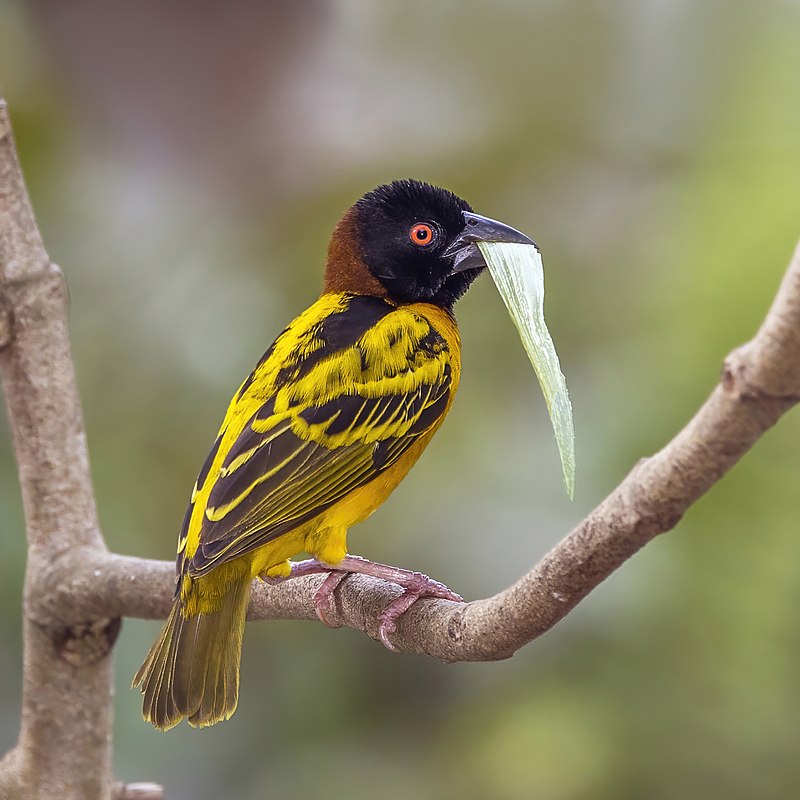
The Village Weaver is a bird found in sub-Saharan Africa, as well as on islands like Hispaniola and Martinique.
It has distinctive black heads with white spots on its back and wings.
They feed mainly on seeds but also eat some insects. The males build nests made of grasses that hang from branches or trees to attract mates during breeding season.
These birds are social creatures often seen in pairs or small groups foraging together in the same area.
Their calls are melodious chirps which can be heard throughout their range when they communicate danger or alert each other of food sources nearby.Scientific classification:
| Kingdom | Animalia |
| Phylum | Chordata |
| Class | Aves |
| Order | Passeriformes |
| Family | Ploceidae |
| Genus | Ploceus |
| Species | P. cucullatus |
25. Turaco
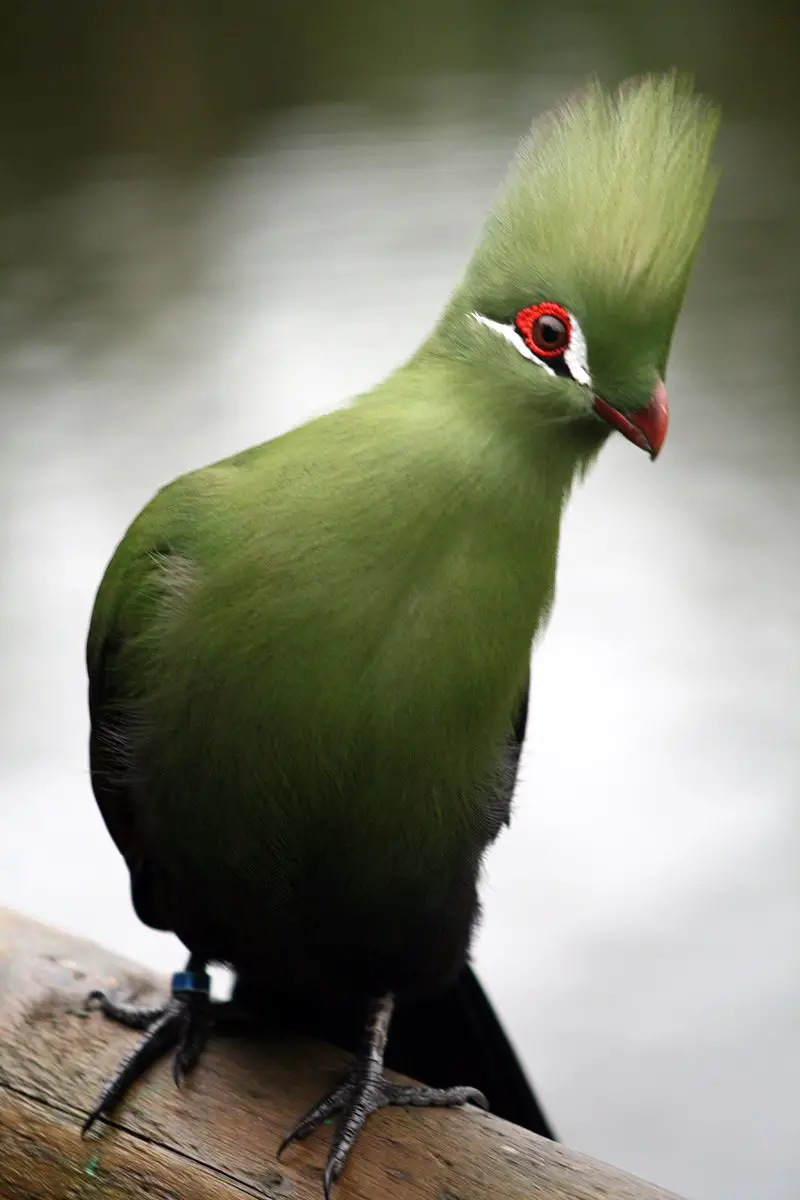
Turacos are a unique bird family that inhabit tropical and subtropical regions of Africa. They are also known as “banana-eaters” or “loeries” in southern Africa, due to their diet which consists mostly of fruit such as plantains.
These birds have an interesting semi-zygodactylous foot structure – the fourth toe can be switched back and forth while the second and third toes remain conjoined.
Turacos come in different sizes depending on species but they all generally boast bright colors like green, blue, purple or red feathers with vibrant yellow eyes.
In addition to being beautiful creatures, these birds make loud calls during mating season which makes them even more special.Scientific classification:
| Kingdom | Animalia |
| Phylum | Chordata |
| Class | Aves |
| Clade | Otidimorphae |
| Order | Musophagiformes Seebohm, 1890 |
| Family | Musophagidae Lesson, 1828 |
26. Stone-Curlew

Stone-curlews, also known as dikkops or thick-knees, are a family of birds that have adapted to live in tropical and temperate regions throughout the world.
They can be found in Africa, Asia and Australia with two or more species per region. Despite being classified as waders, most prefer dry arid habitats over moist wetlands.
Stone-curlews typically have long legs which help them navigate through their preferred terrain efficiently; some species even stand at an impressive height when standing on those long legs.
Additionally they feature cryptic plumage which helps them blend into their surroundings while hunting for prey such as insects and small mammals like rodents.
These unique bird’s calls are easily recognizable; it has been said that hearing one is similar to listening to someone whistling ‘Keee Weee’.Scientific classification:
| Kingdom | Animalia |
| Phylum | Chordata |
| Class | Aves |
| Order | Charadriiformes |
| Suborder | Chionidi |
| Family | Burhinidae Mathews, 1912 |
27. Brown-Throated Wattle-Eye
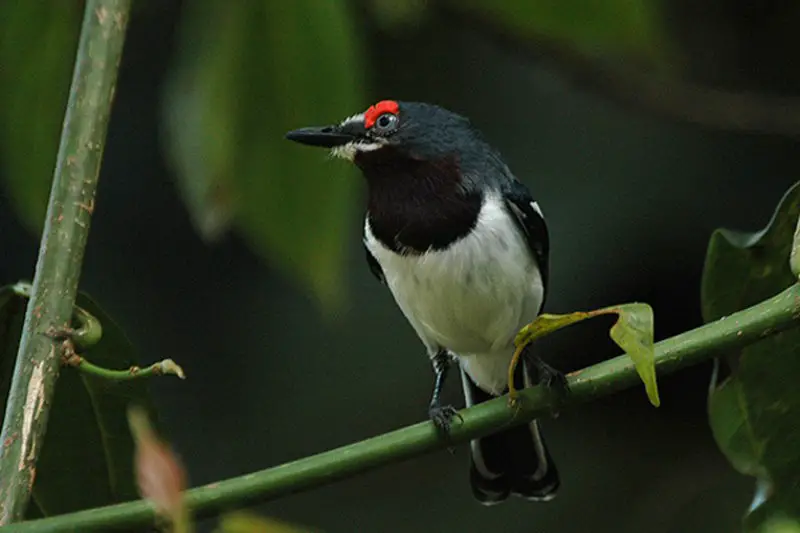
The Brown-throated Wattle-eye is a small and insectivorous passerine bird belonging to the family of Muscicapidae. It usually lives in tropical Africa, being found mainly in western, central and northeast regions.
As it has an eye-catching scarlet spectacled face, this species can be easily spotted due its bright colours. Its diet consists mostly on insects but also eat some fruits or even nectar from flowers when available.
This specie is known for its fast movements as they are good fliers that quickly switch between trees branches looking for food or shelter during rainy days.
They build their nests close to each other providing them with safety against predators thanks to their flock behavior which makes of them one beautiful sight to observe.Scientific classification:
| Kingdom | Animalia |
| Phylum | Chordata |
| Class | Aves |
| Order | Passeriformes |
| Family | Platysteiridae |
| Genus | Platysteira |
| Species | P. cyanea |
28. Scarlet-Chested Sunbird
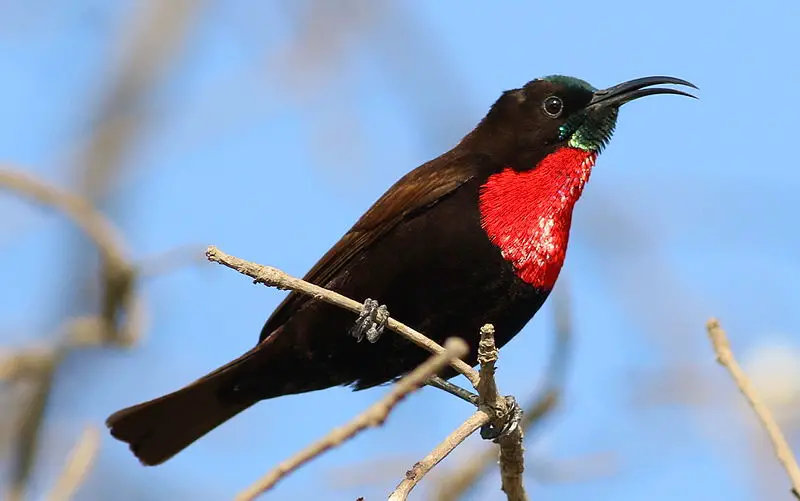
The Scarlet-chested Sunbird is a vibrant species that can be found in many countries across Africa.
It has striking scarlet feathers on its chest, with the rest of its body being mainly black and white.
This bird feeds mainly on insects, but will also feed on fruits, nectar and small lizards if needed. They live in open woodlands or savannas where there are trees to nest and forage from.
During breeding season they gather into pairs and make nests high up in trees made out of twigs lined with soft materials such as downy feathers or plant fibers.
The female lays two eggs which both parents incubate until hatching time comes around after about 2 weeks.
These birds are very social creatures who flock together when food sources become available – making them an enjoyable sight to behold.Scientific classification:
| Kingdom | Animalia |
| Phylum | Chordata |
| Class | Aves |
| Order | Passeriformes |
| Family | Nectariniidae |
| Genus | Chalcomitra |
| Species | C. senegalensis |
Also Featured In: Savanna Birds You Need to See,
29. Long-Tailed Glossy Starling
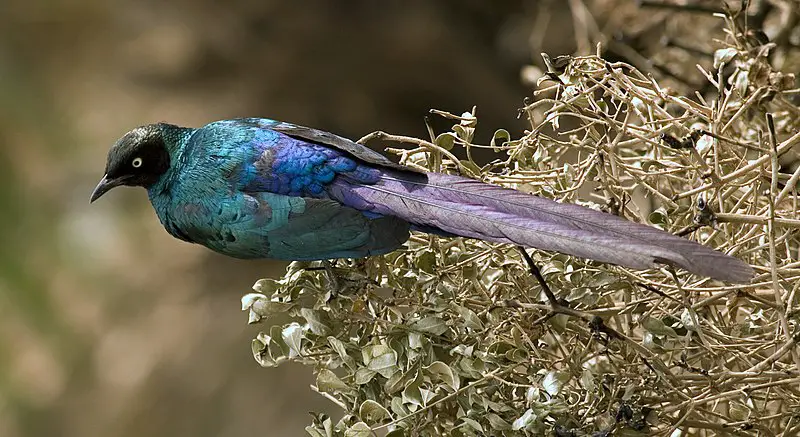
The Long-tailed glossy starling is a vibrant and elegant member of the starling family. It ranges from Senegal in West Africa to Sudan in East Africa, inhabiting open woodlands and cultivated areas.
As a gregarious bird it can often be heard making loud calls as it flits around its territory.
Its nest is made in holes or cavities within trees or buildings, laying two to four eggs per clutch.
The long tail for which this species gets its name gives an extra splash of colour with iridescent hues that shimmer like jewels when seen under direct sunlight.
Despite being widespread across many African countries, the Long-tailed glossy Starling still faces habitat degradation due to human activities such as deforestation and agricultural expansion leading to reduced populations overall – something we should all work towards conserving for future generations.Scientific classification:
| Kingdom | Animalia |
| Phylum | Chordata |
| Class | Aves |
| Order | Passeriformes |
| Family | Sturnidae |
| Genus | Lamprotornis |
| Species | L. caudatus |
30. White-Faced Whistling Duck
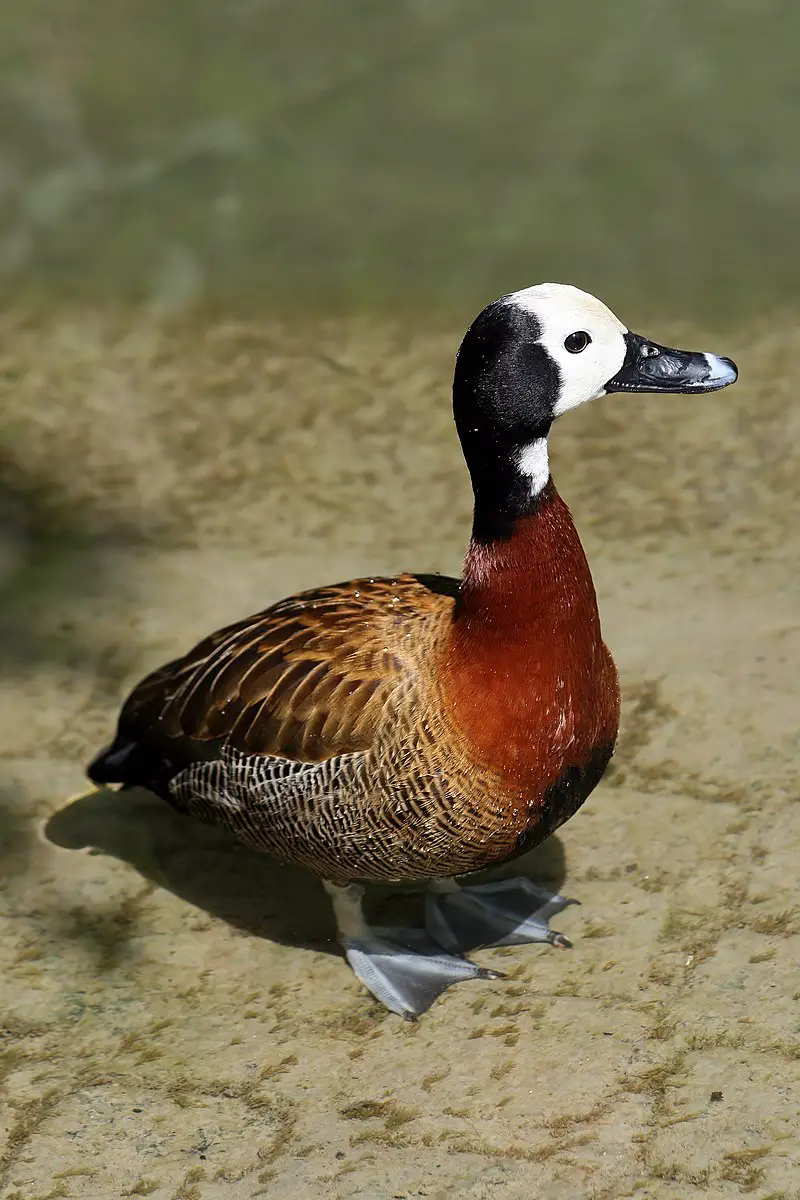
The white-faced whistling duck is a highly social bird native to sub-Saharan Africa and South America. It can be easily identified by its distinct three-note whistling call, as well as its long grey bill.
In the right conditions, it’s not uncommon to spot large flocks of these ducks numbering in the thousands at dawn – an incredible sight.
This species usually lives near bodies of water such as swamps or rivers where they feed on plant matter like grasses and grains which they graze on during the day.
When night falls, they fly off into trees nearby in search of safety from predators before returning to their feeding grounds when morning arrives again.Scientific classification:
| Kingdom | Animalia |
| Phylum | Chordata |
| Class | Aves |
| Order | Anseriformes |
| Family | Anatidae |
| Genus | Dendrocygna |
| Species | D. viduata |
31. Red-Eyed Dove
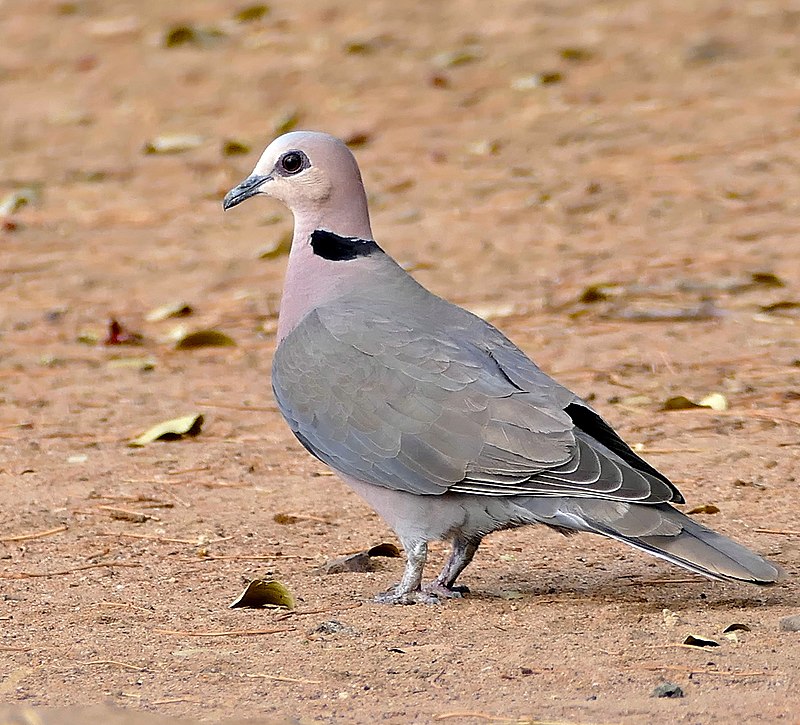
The red-eyed dove (Streptopelia semitorquata) is an attractive bird native to Sub-Saharan Africa. It was first described by German naturalist Eduard Rüppell in 1835, and since then has been listed as Least Concern on the IUCN Red List.
These birds have a distinct appearance with greyish brown upperparts, paler underparts and a distinctive half collar of dark feathers around their neck.
They also have bright red eyes that contrast sharply against their otherwise dull plumage.
The diet of the red-eyed dove consists mostly of seeds and grains found on the ground or from shrubs, but they will occasionally eat insects too.
All in all this species is quite common across its range making it one of nature’s most eye catching creatures.Scientific classification:
| Kingdom | Animalia |
| Phylum | Chordata |
| Class | Aves |
| Order | Columbiformes |
| Family | Columbidae |
| Genus | Streptopelia |
| Species | S. semitorquata |
32. Diederik Cuckoo
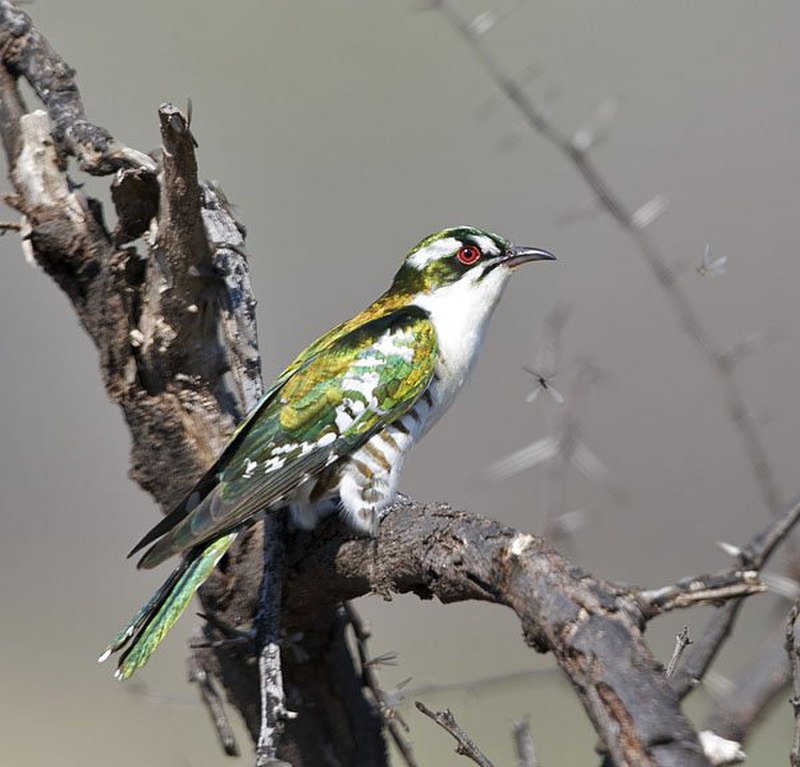
The Diederik Cuckoo is a small and beautiful bird native to the Cape of Good Hope region in South Africa. It has an attractive plumage with black, white and grey feathers covering its body.
Its flight is agile as it soars through the air gracefully on long wings.
The species gets its name from Dutch colonialist Jan van Riebeeck who named it after his friend Diederik Westerwoltz when they encountered one together in 1662 near Table Bay.
This cuckoo prefers open woodlands where they can find their preferred food items like grasshoppers, crickets and caterpillars among others.
They are also known for laying eggs in other birds’ nests which leads to them being adopted by these unsuspecting hosts unknowingly.Scientific classification:
| Kingdom | Animalia |
| Phylum | Chordata |
| Class | Aves |
| Order | Cuculiformes |
| Family | Cuculidae |
| Genus | Chrysococcyx |
| Species | C. caprius |
33. Painted-Snipe
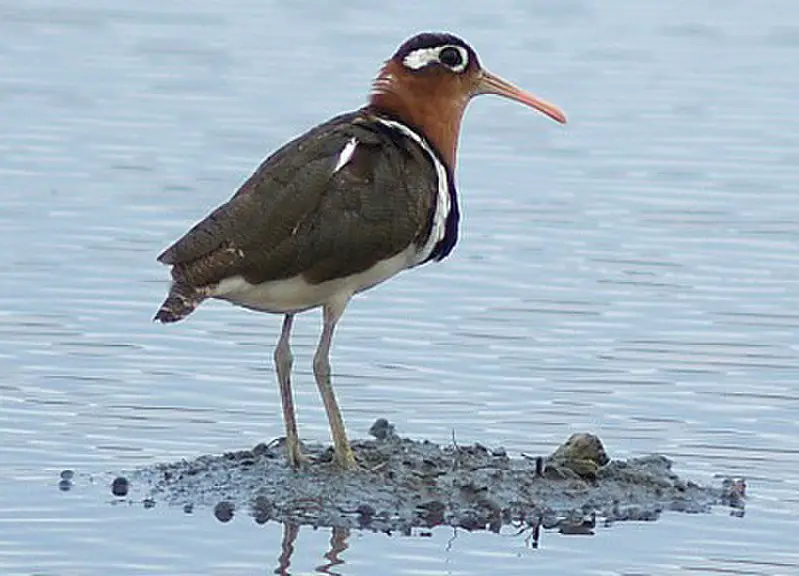
Painted snipes are beautiful and unique wading birds found in the Rostratulidae family. They have short legs, long bills, and a striking plumage which distinguishes them from true snipes.
Males tend to be smaller than females with duller overall coloration. There are three species of painted snipe.
The Greater Painted Snipe, Lesser Painted Snipe, and Australian Painted Snipe – all three have different habitats ranging from wetland pools to grasslands or mangroves depending on their region.
These birds feed mainly on earthworms but also consume insects, crustaceans and plant material when available.
As they rely heavily on wetlands for breeding purposes it is important that we protect these precious habitats so that this special bird can continue to thrive.Scientific classification:
| Kingdom | Animalia |
| Phylum | Chordata |
| Class | Aves |
| Order | Charadriiformes |
| Suborder | Thinocori |
| Family | Rostratulidae Coues, 1888 |
34. Honeyguide
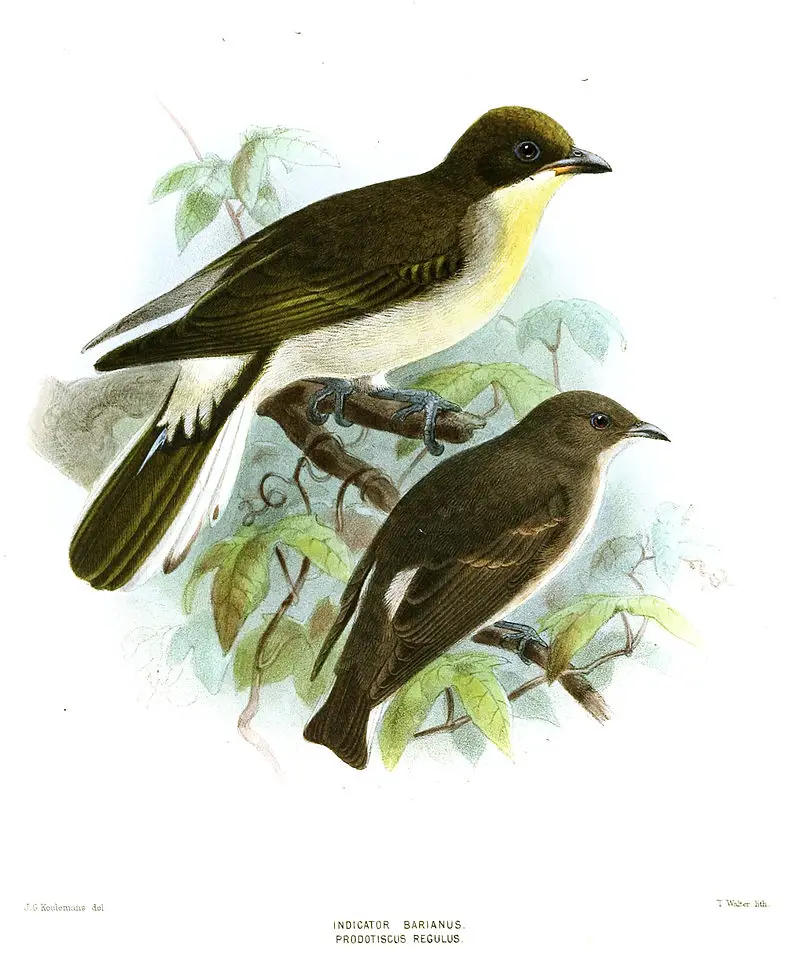
Honeyguides are small, near passerine birds belonging to the family Indicatoridae. Native to tropical regions of Asia and Africa, they’re best known for their unique relationship with humans.
They have a mutualistic association with people by leading them towards bee colonies in exchange for wax or honey from the hive after it has been opened up.
Honeyguide birds use special calls that sound like ‘tink-tink’ or ‘hweet hwuit’, which is thought to be their way of telling potential partners about food sources available nearby.
This remarkable ability makes them an invaluable resource for local communities and indigenous groups who rely on wild bees as a source of income and nutrition.Scientific classification:
| Kingdom | Animalia |
| Phylum | Chordata |
| Class | Aves |
| Order | Piciformes |
| Infraorder | Picides |
| Family | Indicatoridae Swainson, 1837 |
35. Yellow-Crowned Gonolek
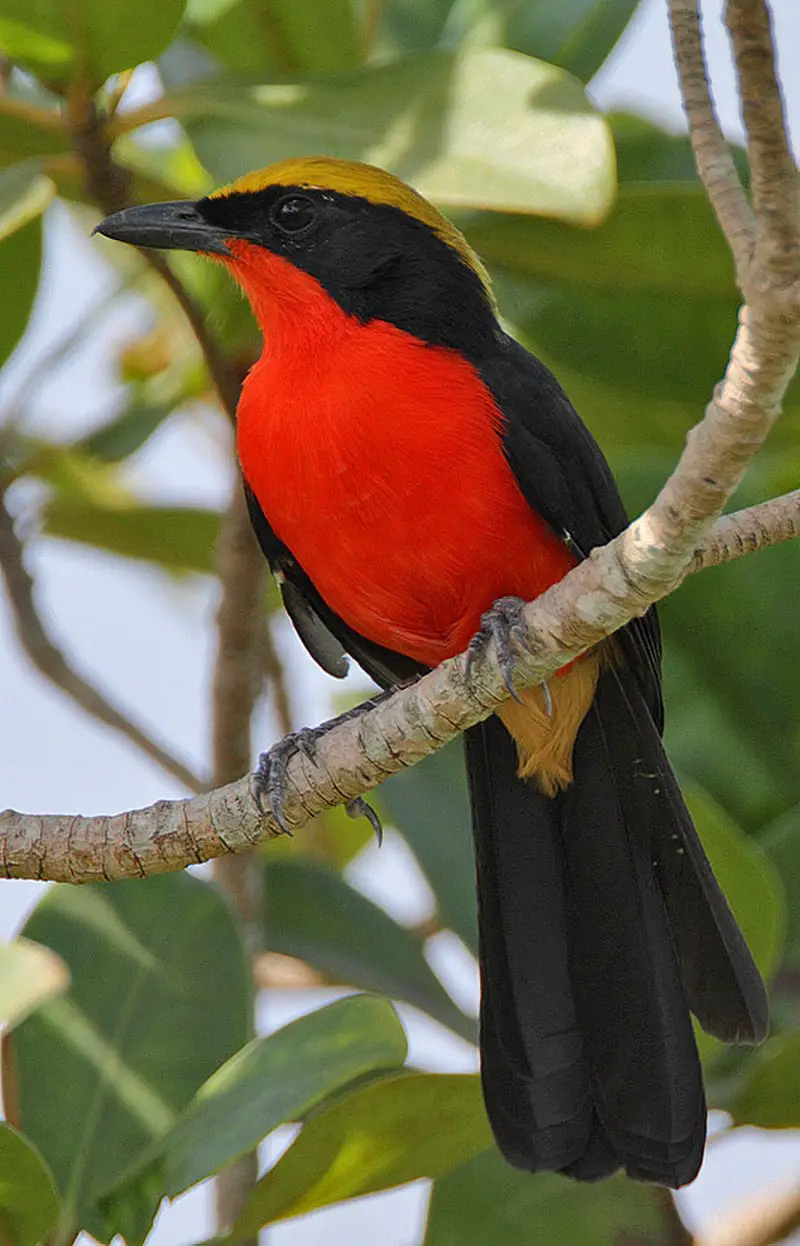
The Yellow-crowned Gonolek is a common resident bird of equatorial Africa, found from Senegal to Ethiopia. It lives in dense undergrowth and wooded habitats, typically nesting in cup structures within bushes or trees.
This medium-sized passerine has striking plumage consisting of black wings with white spots, a yellowish crown and nape, brown body feathers streaked with cream markings and orange legs.
Its diet consists mainly of insects such as grasshoppers and caterpillars which it hunts by scanning the ground while perched on branches or flying low over vegetation searching for prey items.
The call of this species is an unmistakable loud “weeoo” often heard early morning when they are most active.
These birds form monogamous pairs that breed year round depending upon environmental conditions resulting in clutches containing up to five eggs being laid each seasonScientific classification:
| Kingdom | Animalia |
| Phylum | Chordata |
| Class | Aves |
| Order | Passeriformes |
| Family | Malaconotidae |
| Genus | Laniarius |
| Species | L. barbarus |
36. African Harrier-Hawk
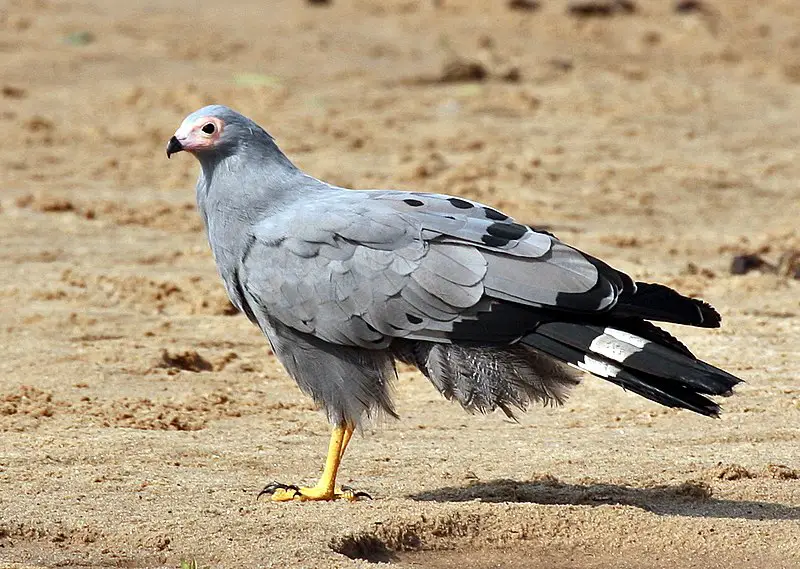
The African harrier-hawk is a medium sized bird of prey, measuring around 60 to 66 centimetres in length. It has pale grey upperparts, head and breast and its wings are broad with black primaries.
The under parts are white barred with dark brown or black stripes on the belly and thighs.
Its tail is quite long compared to other hawks, typically banded blackish above while below it’s reddish buff marked by narrow crossbars.
This species breeds mainly south of the Sahara desert in Africa but can also be found occasionally as far north as Ethiopia and Sudan during winter months when they migrate for food sources such as rodents, small birds & reptiles which make up their diet in addition to carrion at times too.Scientific classification:
| Kingdom | Animalia |
| Phylum | Chordata |
| Class | Aves |
| Order | Accipitriformes |
| Family | Accipitridae |
| Genus | Polyboroides |
| Species | P. typus |
Also Featured In: Birds that You’ll Find in Kruger national park,
37. Verreaux’s Eagle-Owl
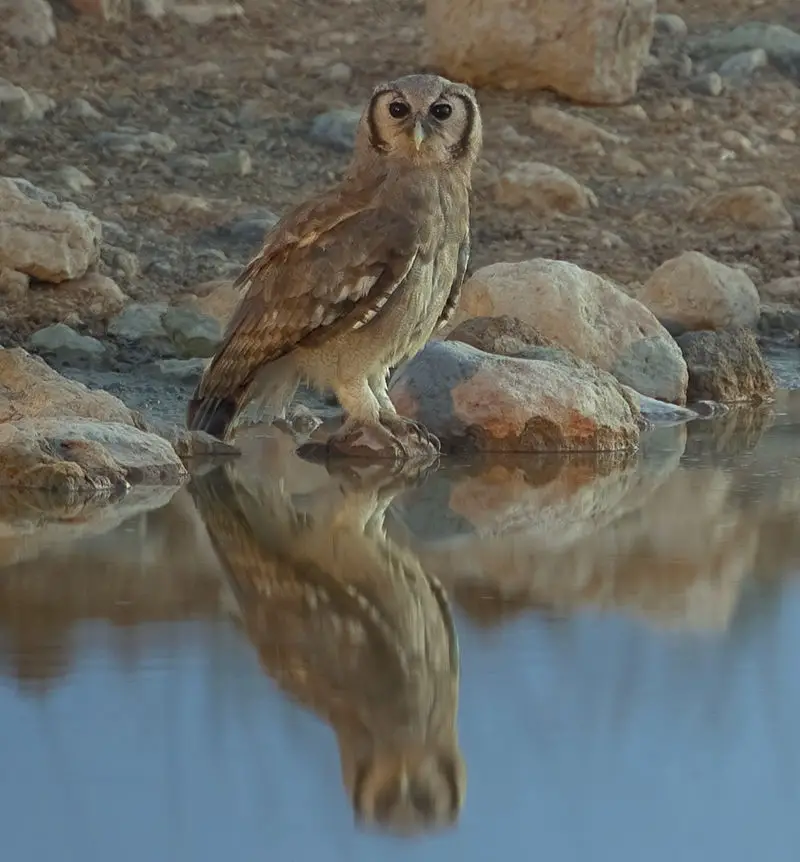
Verreaux’s eagle-owl is a magnificent bird that can be found in dry, wooded savannas of sub-Saharan Africa. It is the largest African owl and measures up to 66 cm (26 inches) long.
This majestic creature has grey plumage with white spots on its back and wings, while its face is covered by an impressive facial disk.
Its eyes are yellowish orange in color, surrounded by white feathers which give it a striking appearance.
These birds hunt mostly during the night but may occasionally also do so during daylight hours when food becomes scarce or if they have recently hatched young ones who need feeding.
Verreaux’s eagle-owls live alone or in pairs for much of the year until breeding season comes around after which two eggs will be laid at once and incubated for about 30 days before hatching into fluffy chicks.Scientific classification:
| Kingdom | Animalia |
| Phylum | Chordata |
| Class | Aves |
| Order | Strigiformes |
| Family | Strigidae |
| Genus | Bubo |
| Species | B. lacteus |
38. Black-Headed Lapwing
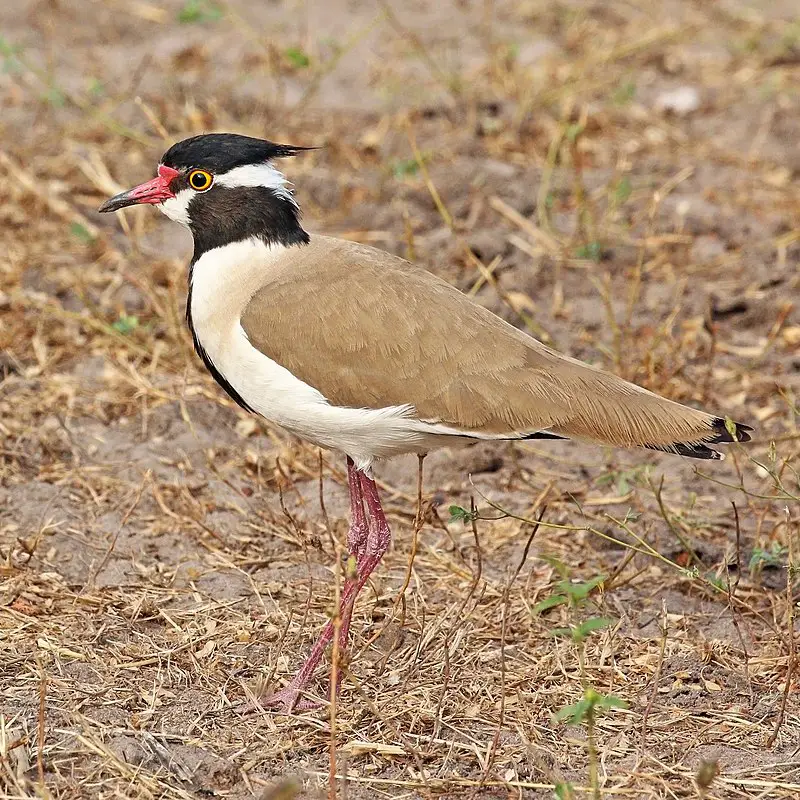
The Black-headed Lapwing is a large and unmistakable bird belonging to the family Charadriidae. It can be found across sub-Saharan Africa from Senegal to Ethiopia, where it breeds residentially but may still move seasonally.
They have black heads, white underparts and grey wings with distinctive chestnut wing patches which make them easily distinguishable in their habitat.
Their eggs are laid two or three at a time on scrapes in the ground and they can often be seen foraging near streams or other bodies of water during breeding seasons.
These birds possess an impressive array of vocalisations which vary by region; including shrill whistles and sharp cries that sound like “seep seep”.Scientific classification:
| Kingdom | Animalia |
| Phylum | Chordata |
| Class | Aves |
| Order | Charadriiformes |
| Family | Charadriidae |
| Genus | Vanellus |
| Species | V. tectus |
39. Bronze Mannikin
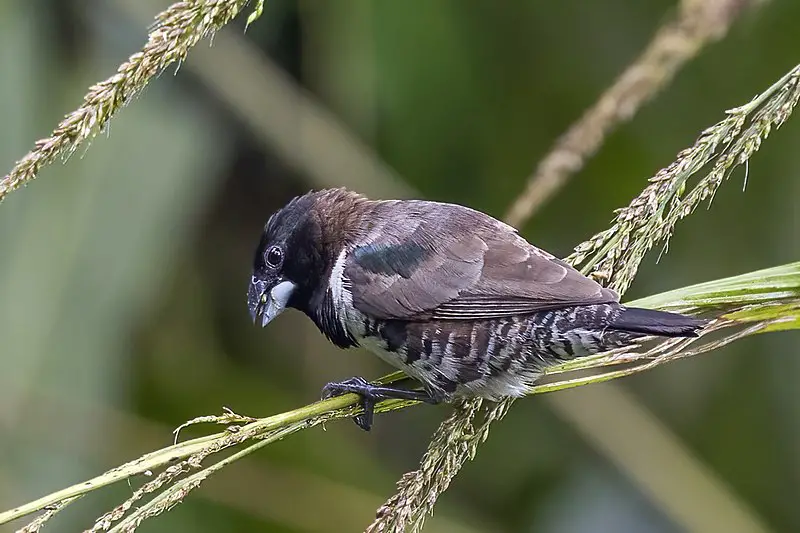
The Bronze Mannikin is a small passerine bird that lives in the Afrotropic region. It’s an uncommon to locally abundant species found south of the Sahara Desert, usually inhabiting mesic savanna or forest margins.
With its estimated 8,100,000 km2 global range of occurrence, it can be quite common in some places and rare in others.
This social finch loves being around people and other birds; it even has been known to join mixed flocks alongside larks and pipits.
Its vibrant feathers make for a stunning sight as it perches on tree branches singing joyfully throughout the day.Scientific classification:
| Kingdom | Animalia |
| Phylum | Chordata |
| Class | Aves |
| Order | Passeriformes |
| Family | Estrildidae |
| Genus | Spermestes |
| Species | S. cucullata |
40. Grey-Headed Kingfisher
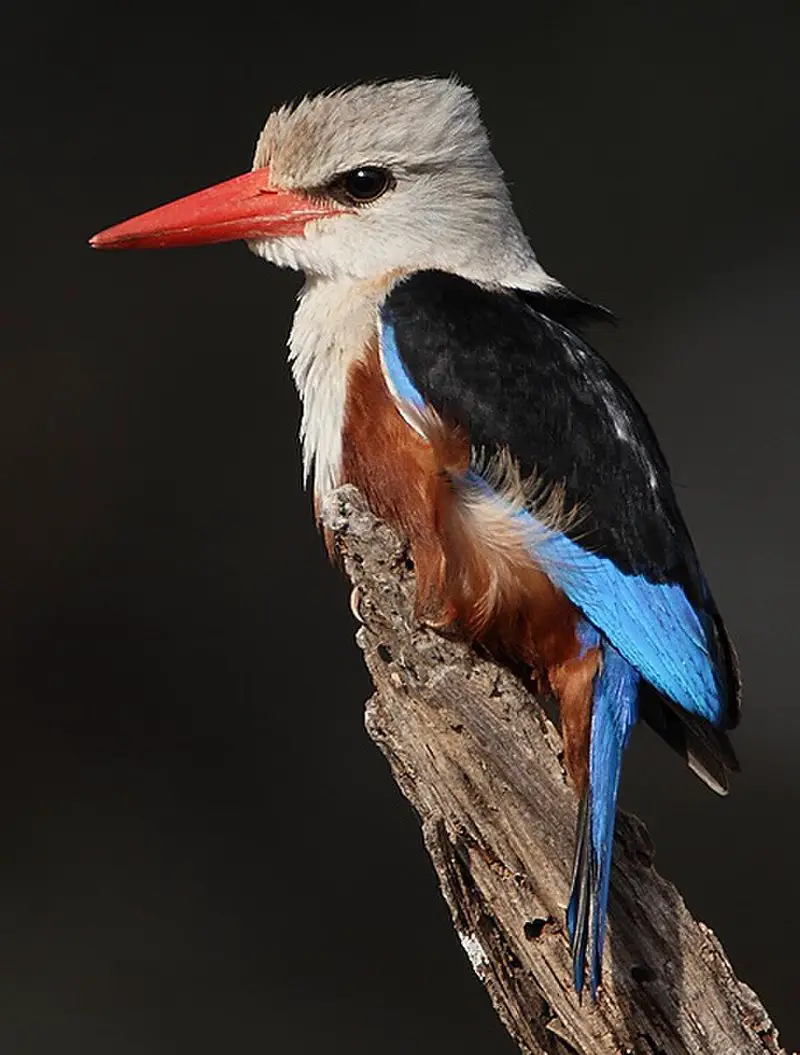
The Grey-headed Kingfisher is a stunning species of kingfisher that can be found across much of Africa and the Middle East. Its striking grey head, white neck, black back and wings with blue speckles make it an instantly recognizable bird.
It has been described formally by German zoologist Philipp Ludwig Statius Müller since 17.
This small but beautiful predator feeds mainly on insects such as beetles, grasshoppers and cicadas which they catch while hovering over water or in flight from perches up to 20 meters above ground level.
They are monogamous birds who will form lifelong pair bonds during mating season when males display courtship behavior including tail fanning and bill clacking displays at their chosen mate’s nest site.
These little birds play an important part in African ecosystems so we should all take care to preserve them for future generations.Scientific classification:
| Kingdom | Animalia |
| Phylum | Chordata |
| Class | Aves |
| Order | Coraciiformes |
| Family | Alcedinidae |
| Subfamily | Halcyoninae |
| Genus | Halcyon |
| Species | H. leucocephala |
41. Speckled Pigeon
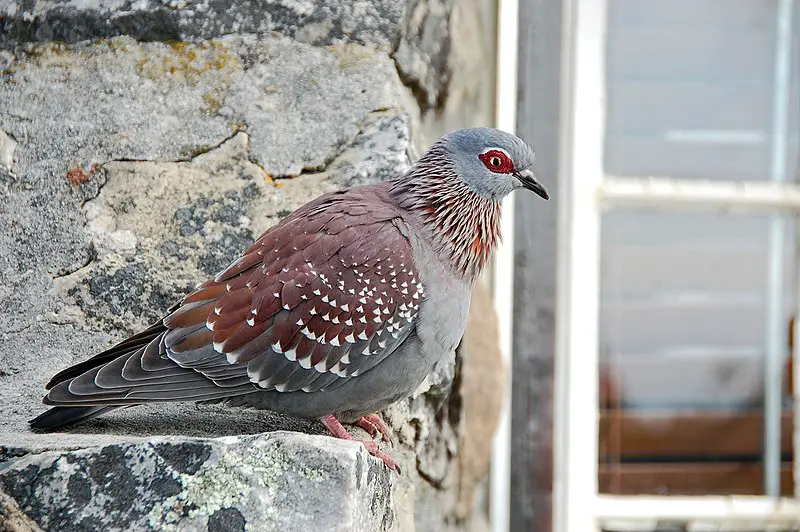
The Speckled Pigeon, also known as the African Rock Pigeon or Guinea pigeon due to its similar coloring to some species of guineafowl, is a resident breeding bird in much of Africa south of the Sahara.
It’s commonly seen inhabiting open habitats and has been around since 1747 when it was first described by Swedish naturalist Carl Linnaeus.
These birds usually have grey bodies with speckles on their wings, although they can vary from brownish-grey to dark slate blue depending on where they’re found geographically.
They feed mostly on seeds and other grain crops but will sometimes supplement that diet with insects if available.
In general these pigeons are harmless unless threatened – so be sure not to startle them.Scientific classification:
| Kingdom | Animalia |
| Phylum | Chordata |
| Class | Aves |
| Order | Columbiformes |
| Family | Columbidae |
| Genus | Columba |
| Species | C. guinea |
42. Mourning Collared Dove
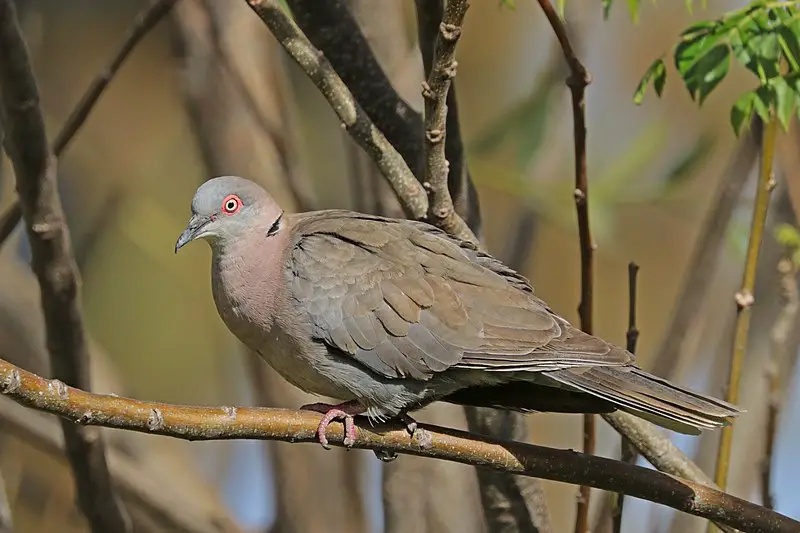
The Mourning Collared Dove is a species of dove found in Africa south of the Sahara. It is large, stocky and has distinct markings on its wings that resemble collars.
Its diet consists mainly of grains and seeds which it finds near water sources where it often mingles with other doves peacefully.
This bird makes cooing sounds as part of its courtship ritual to attract mates but also vocalises alarm calls when threatened or startled by predators.
They are widespread across their habitat range and commonly seen perched atop trees or flying about during dawn & dusk hours.
These birds make interesting avian companions for humans who appreciate their gentle nature & graceful beauty.Scientific classification:
| Kingdom | Animalia |
| Phylum | Chordata |
| Class | Aves |
| Order | Columbiformes |
| Family | Columbidae |
| Genus | Streptopelia |
| Species | S. decipiens |
43. Lesser Moorhen
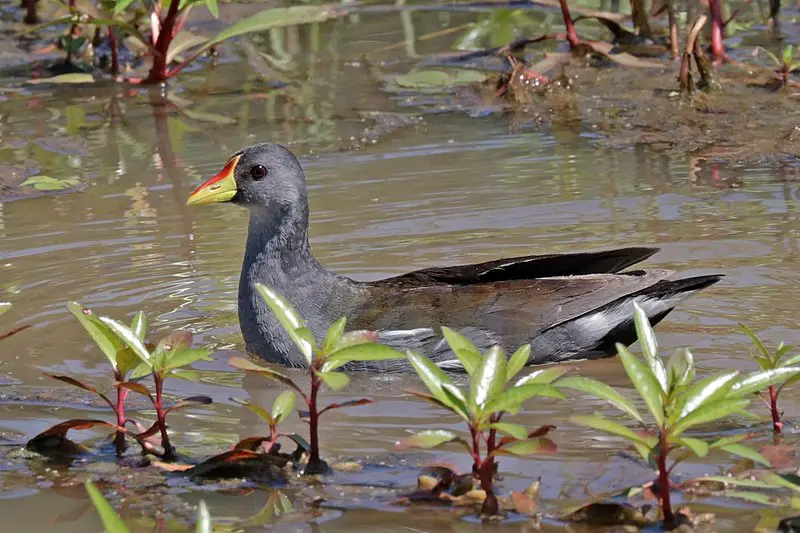
The Lesser Moorhen is a species of bird belonging to the family Rallidae. It is found in Sub-Saharan Africa, but not Southern Africa or Madagascar.
This species was previously placed in the genus Gallinula, however a 2015 study revealed its genetic distinctiveness which led it to be placed into the newly established Paragallinula genus.
It has an overall dark brown plumage with white underparts and distinctive yellow legs.
Its bill is also yellowish-brown and hooked at the tip for catching prey such as insects, crustaceans and molluscs from shallow water bodies like marshes, ponds rivers etc., where they are commonly seen swimming about.Scientific classification:
| Kingdom | Animalia |
| Phylum | Chordata |
| Class | Aves |
| Order | Gruiformes |
| Family | Rallidae |
| Genus | Paragallinula Sangster, Garcia-R & Trewick, 2015 |
| Species | P. angulata |
44. Long-Tailed Nightjar
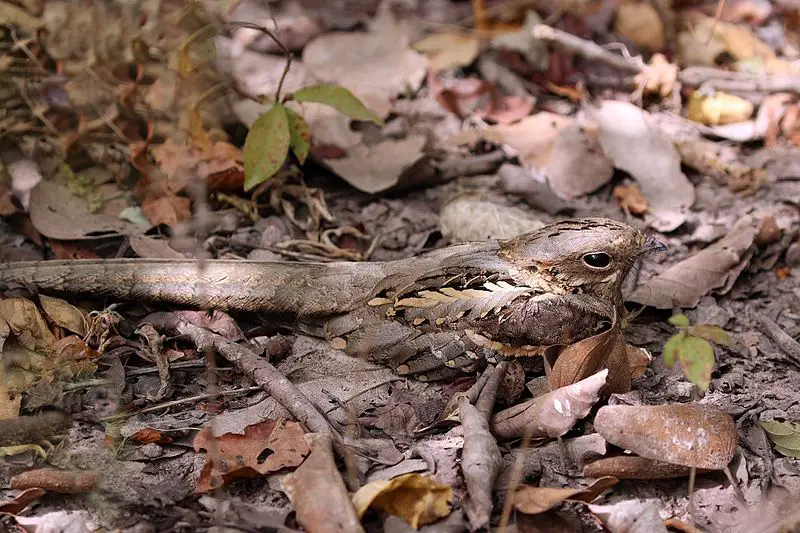
The Long-tailed Nightjar is a small bird native to multiple African countries. It belongs to the family of Caprimulgidae, and has large eyes which allows it to be active at night.
In addition, its wingspan can reach up to 25cm in length – making it one of the larger species within this group.
Its plumage consists mainly of greyish brown with darker markings on both upperparts and underparts; males also have white patches near their tail feathers for added camouflage during flight.
The long-tailed nightjar’s diet consists mostly of insects such as moths, dragonflies and beetles that they hunt from dusk until dawn by swooping down upon them before catching them midair or sipping nectar from flowers.
This nocturnal bird usually roosts in trees during day time but will sometimes use man made structures like telephone poles or buildings as well.Scientific classification:
| Kingdom | Animalia |
| Phylum | Chordata |
| Class | Aves |
| Order | Caprimulgiformes |
| Family | Caprimulgidae |
| Genus | Caprimulgus |
| Species | C. climacurus |
45. Black-Crowned Tchagra
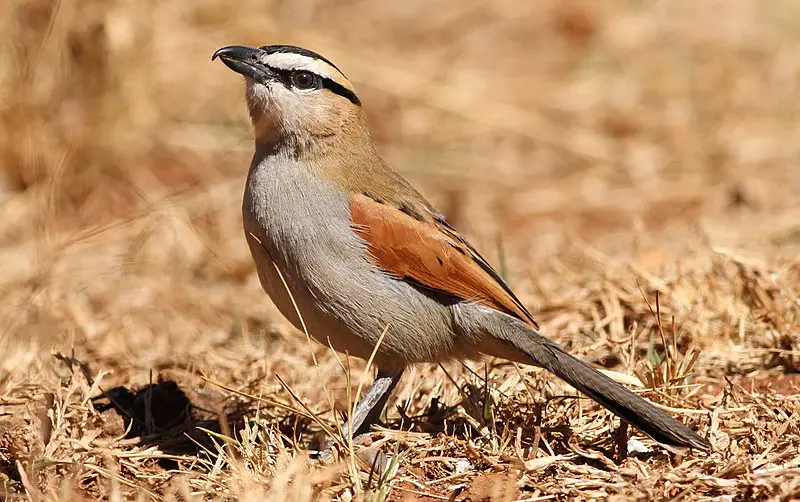
The Black-crowned Tchagra is a bushshrike found in the Arabian peninsula and most of Africa. It inhabits scrub, open woodland, semi-desert and cultivation areas.
This species has distinctive black crown feathers on its head with brown wings and tail that have white stripes running through them.
Its breast is mottled greyish-brown while its throat and belly are off white or pale yellow in colouring making for an attractive bird to behold.
The French zoologist Mathurin Jacques Brisson first described this bird back in 1760 as part of his encyclopedic ornithological work ‘Oiseaux’ (Birds).
Whether you live near the Sahara Desert or not, it can be fun to observe these birds during their active times so keep your eyes peeled.Scientific classification:
| Kingdom | Animalia |
| Phylum | Chordata |
| Class | Aves |
| Order | Passeriformes |
| Family | Malaconotidae |
| Genus | Tchagra |
| Species | T. senegalus |
Also Featured In: Common Algerian Birds , Birds that Live in Benin
46. Black-Billed Wood Dove
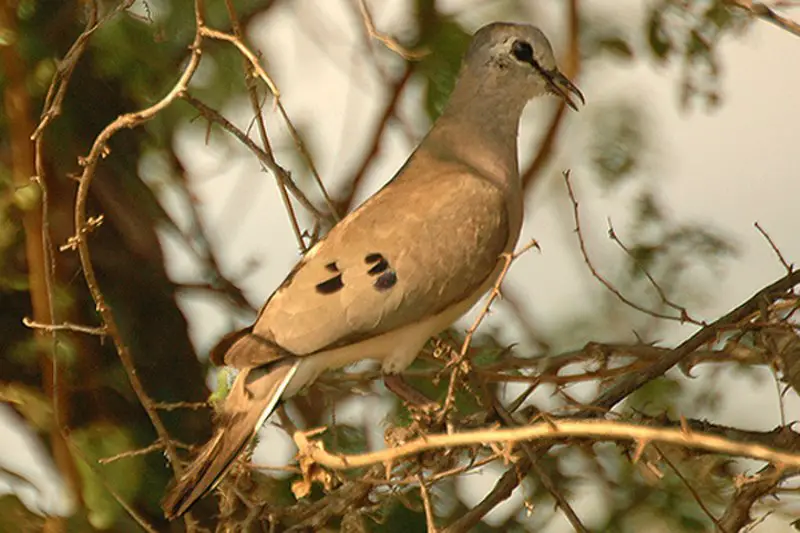
The Black-billed Wood Dove is a beautiful and widespread resident breeding bird found in Africa just south of the Sahara Desert.
It prefers near desert, scrub and savannah habitats to build its stick nest on an acacia tree or similar vegetation.
The dove lays two cream colored eggs which are incubated by both parents for about two weeks before hatching.
When flying, it has quick beats with occasional sharp flicks of wings characteristic of doves. Its diet consists mainly of seeds but also eats some insects and fruits when available during different parts seasons across their range.
This species makes delightful cooing soft sounds which can be heard from far away distances especially at dawns making them even more pleasant to have around.Scientific classification:
| Kingdom | Animalia |
| Phylum | Chordata |
| Class | Aves |
| Order | Columbiformes |
| Family | Columbidae |
| Genus | Turtur |
| Species | T. abyssinicus |
47. Little Bee-Eater
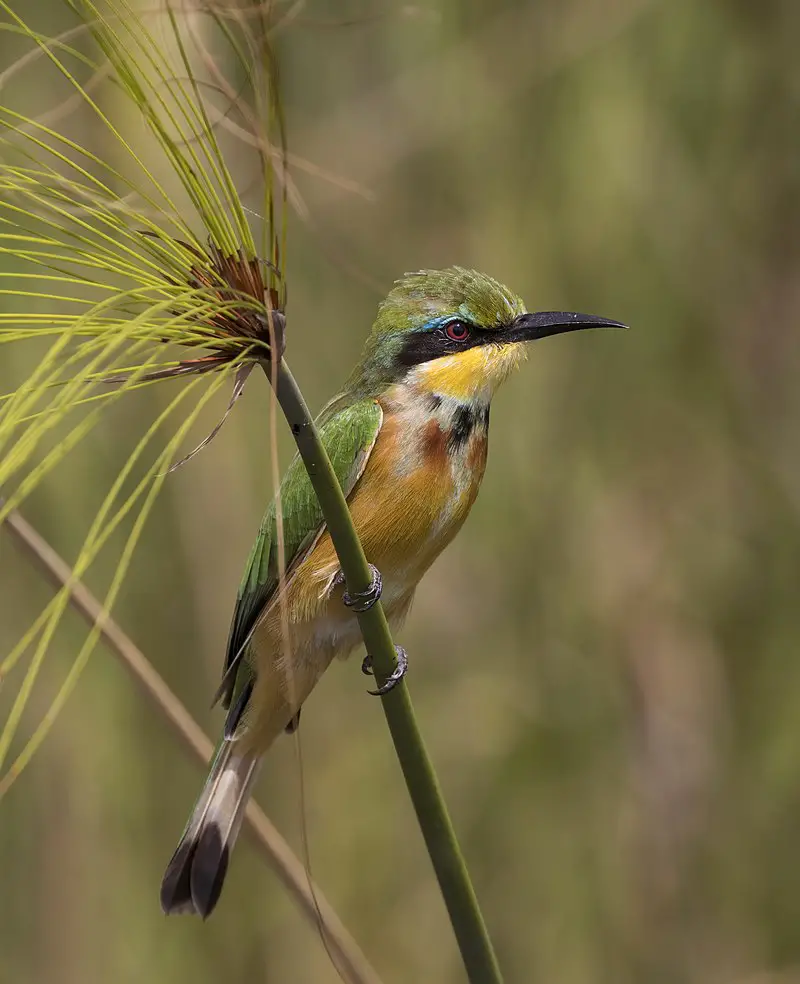
The Little Bee-eater (Merops pusillus) is a beautiful species of bird belonging to the family Meropidae.
These birds are found in much of Sub-Saharan Africa and their migration patterns depend on seasonal rainfall changes.
They have slender, brightly coloured bodies with an iridescent green sheen across the wings and back.
Their diet consists mainly of bees, wasps, dragonflies, moths and other insects which they catch mid-air or from perches above open grasslands or along mudbanks near water sources like rivers and lakes.
In order for these birds to digest their food properly before swallowing it whole, they use pebbles that help them grind up hard exoskeletons so as not to cause any blockages within their digestive tract – something only bee-eaters do.Scientific classification:
| Kingdom | Animalia |
| Phylum | Chordata |
| Class | Aves |
| Order | Coraciiformes |
| Family | Meropidae |
| Genus | Merops |
| Species | M. pusillus |
48. Temminck’s Courser
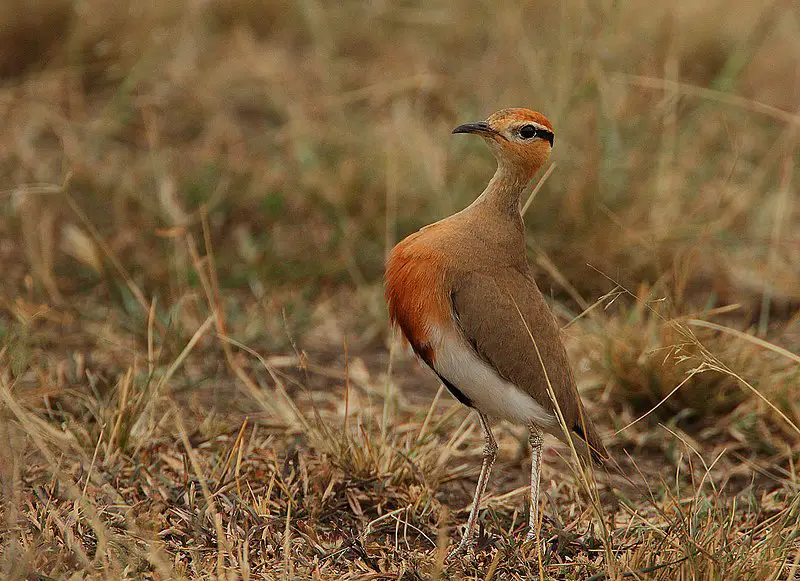
Temminck’s courser is a bird belonging to the pratincole and courser family, Glareolidae.
It is found in sub-Saharan Africa and prefers living in the African savannah where it lays its dark ash-black eggs amongst burnt bushes or grasses.
There are three known subspecies of this wader, which was named after Dutch naturalist Coenraad Jacob Temminck.
This species has greyish upperparts with white underparts while there may be some small black markings on the wings.
The bill and legs of these birds are yellowish brown while their eyes are large and bright red or orange in coloration.
They feed mainly on insects that they catch with short dashes across open ground before returning to cover again as soon as possible; also consuming other arthropods such as spiders when available.
Temminck’s Coursers usually occur singly but sometimes can be seen foraging together during winter months making them an interesting sight for any birder.Scientific classification:
| Kingdom | Animalia |
| Phylum | Chordata |
| Class | Aves |
| Order | Charadriiformes |
| Family | Glareolidae |
| Genus | Cursorius |
| Species | C. temminckii |
49. Greater Honeyguide
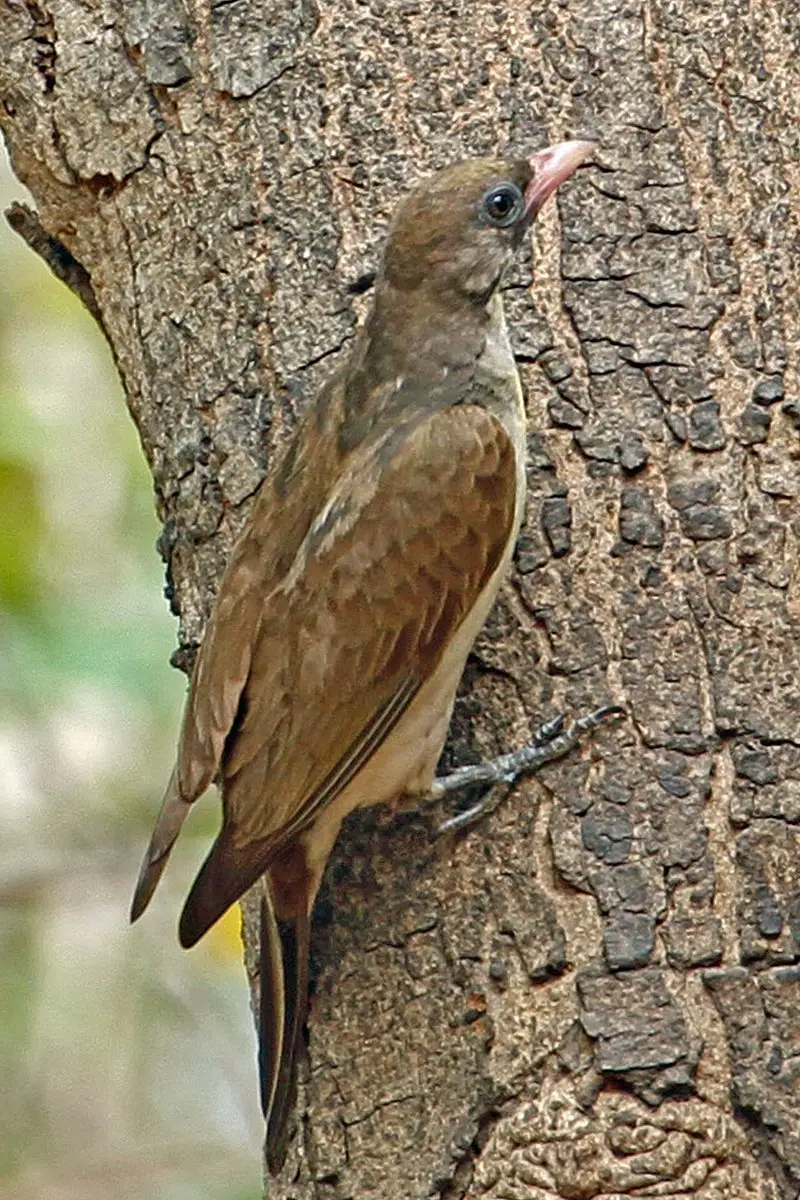
The Greater Honeyguide Bird is a species of bird native to sub-Saharan Africa. It belongs to the family Indicatoridae and is related to woodpeckers.
Its name comes from its behavior of guiding humans or other animals towards bee colonies, though this claim has been disputed.
This bird can be found in various habitats such as forests, savannahs, and bushlands where it feeds on beeswax and larvae after leading others there.
They are monogamous birds that build their nests together out of twigs lined with plant fibers or hair near human settlements like farms or villages for protection against predators.
The female lays two eggs at once which hatch within 12 days before fledging another 17 days afterwards.
These birds play an important role in ecology by helping spread pollen between plants while they search for food sources.Scientific classification:
| Kingdom | Animalia |
| Phylum | Chordata |
| Class | Aves |
| Order | Piciformes |
| Family | Indicatoridae |
| Genus | Indicator |
| Species | I. indicator |
50. Western Reef Heron
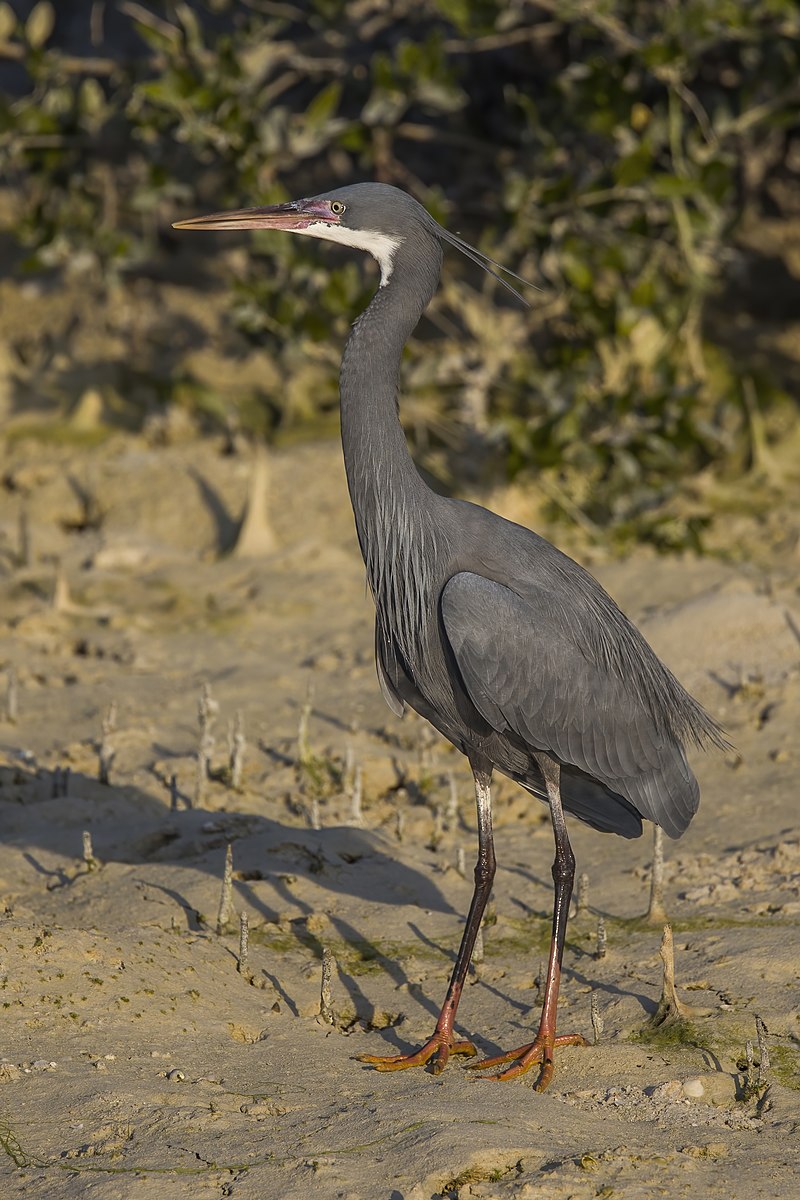
The western reef heron, also known as the western reef egret, is a medium-sized bird found in southern Europe, Africa and some parts of Asia. It usually inhabits coastal areas and has two distinctive plumage forms.
The slaty-grey form can be mistaken for the rare dark morph of the Little Egret while its white form looks similar to that of an immature Grey Heron.
This species feeds mainly on fish but will occasionally eat insects or other small aquatic animals like crabs and molluscs too.
Western Reef Herons are solitary birds that nest near water bodies where they build nests from sticks which may sometimes contain feathers or seaweed as well.
They have become endangered since their habitats have been destroyed due to human activities such as building developments along coastlines; however conservation efforts are being taken to ensure their survival into future generations.Scientific classification:
| Kingdom | Animalia |
| Phylum | Chordata |
| Class | Aves |
| Order | Pelecaniformes |
| Family | Ardeidae |
| Genus | Egretta |
| Species | E. gularis |